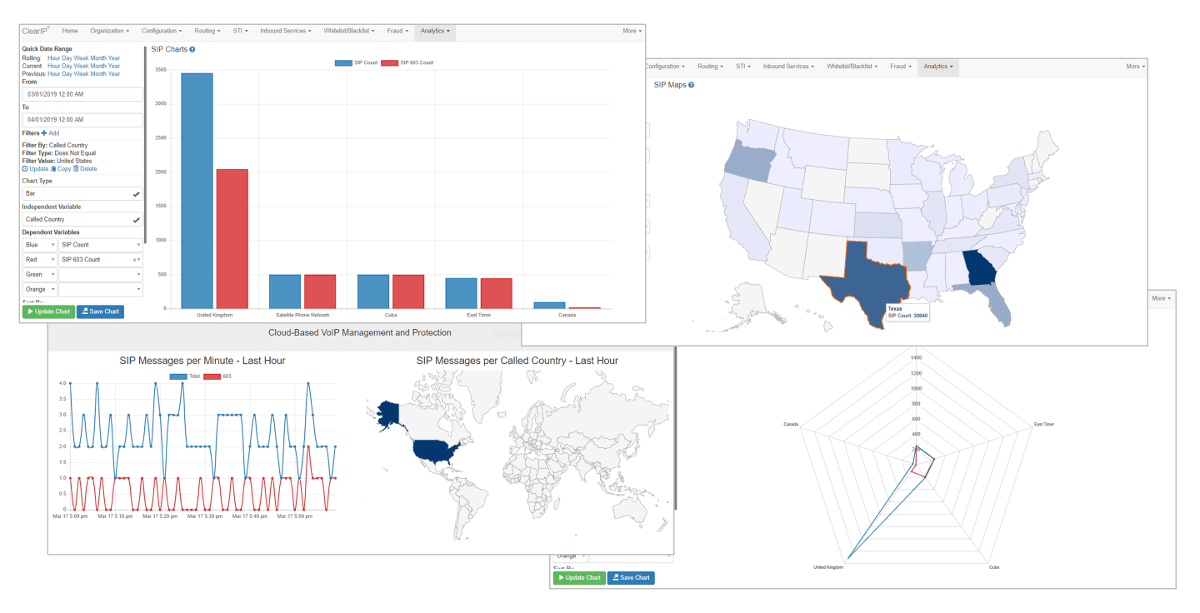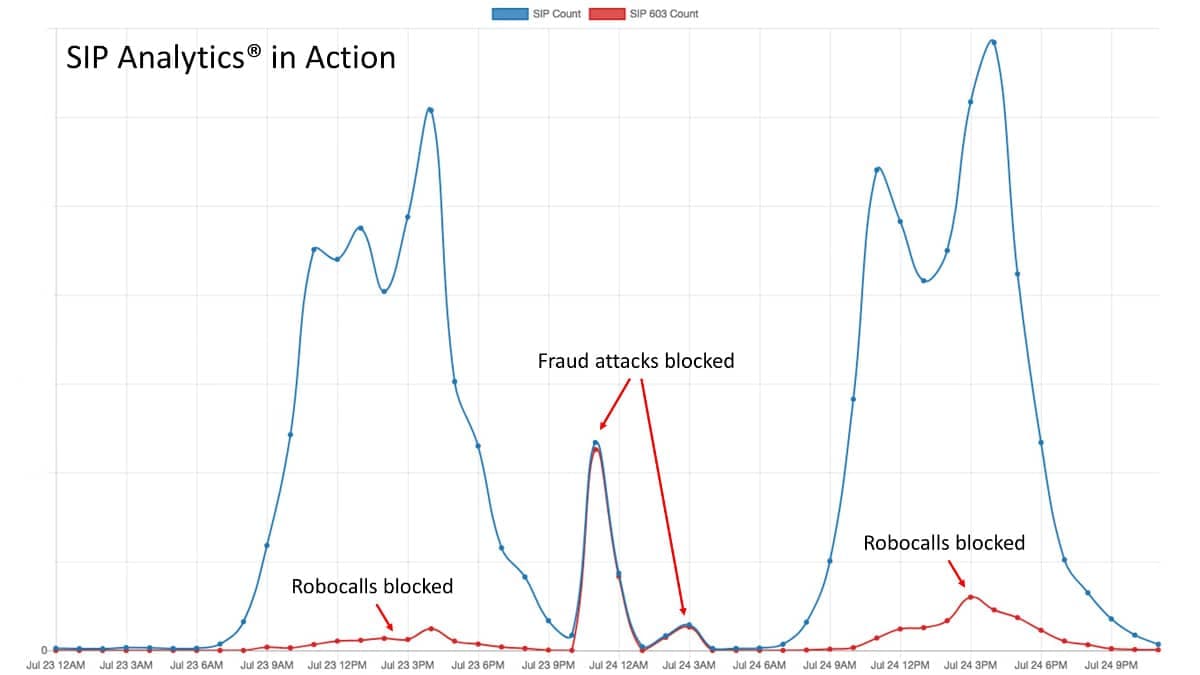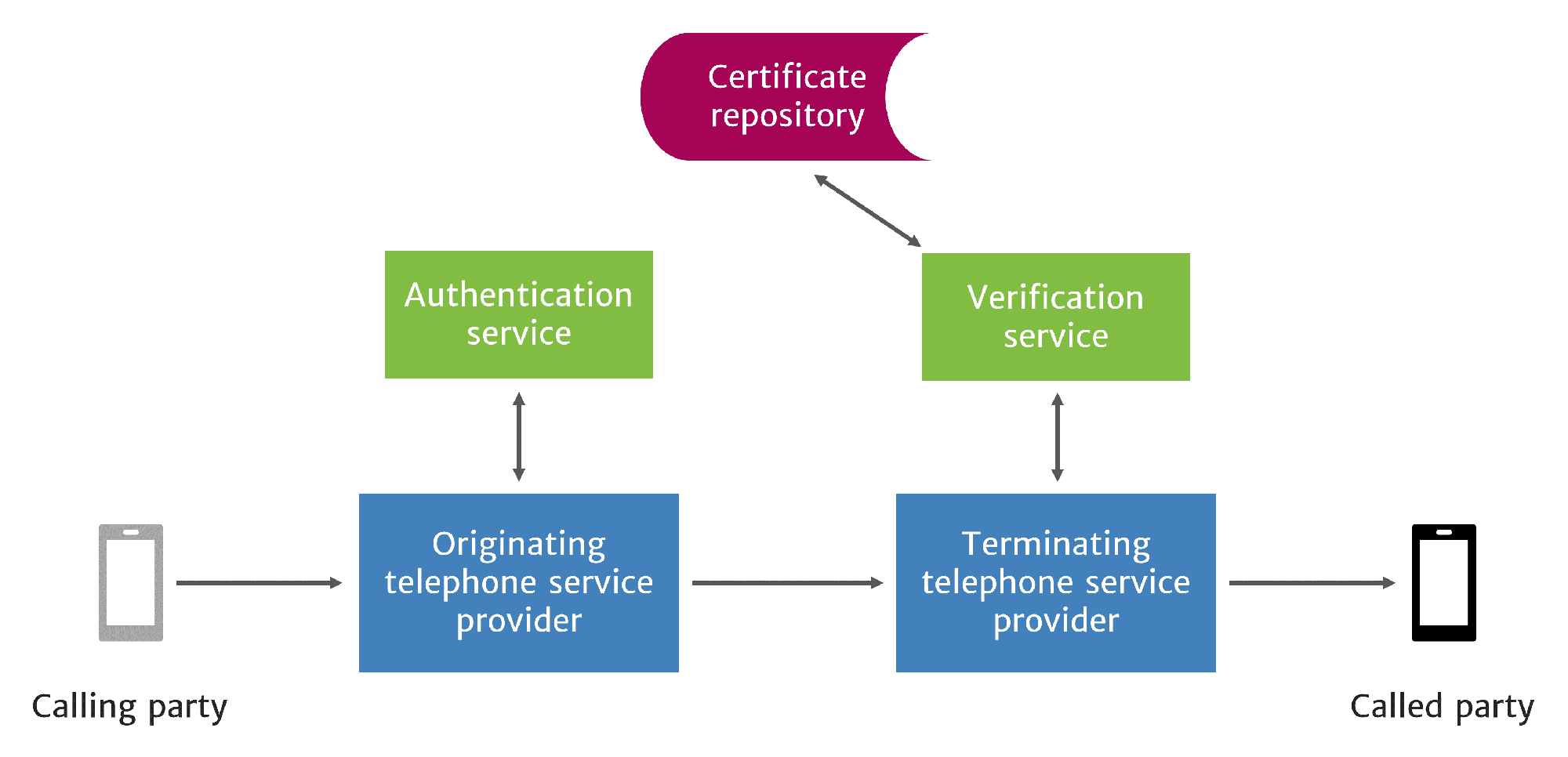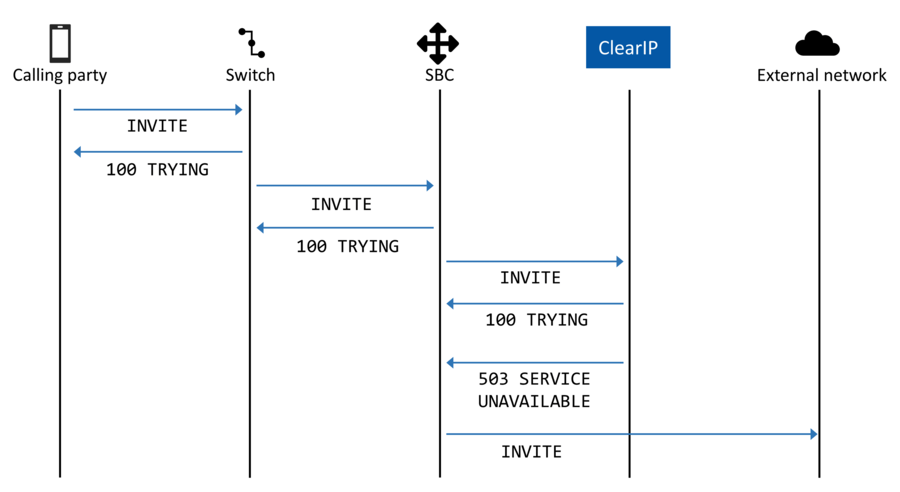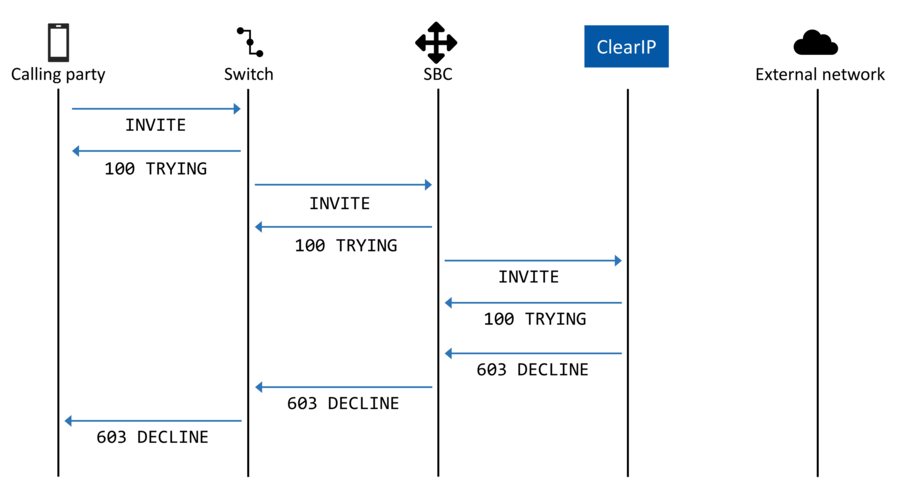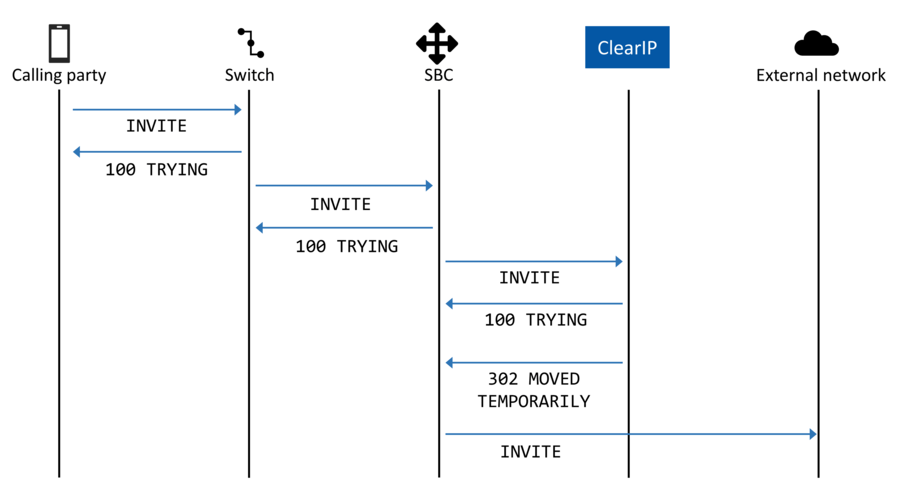ClearIP
Powerful telecom software platform hosted in the cloud
The ClearIP platform provides a comprehensive portfolio of services to manage and protect your telecommunications network.
These services are enabled as you configure them—use what you want and apply them to groups of calls as you wish. ClearIP performs the configured services on each call in one dip for maximum efficiency and effectiveness. It only takes milliseconds.
ClearIP works well with any SIP-based telecom system using a simple integration based upon SIP messaging. Providers, trunks and subscribers are all displayed in the user interface. Custom policies can be configured at any level. Implementation is quick and easy.
ClearIP services are billed monthly based upon usage with no contract or commitment.

Analytics
ClearIP retains call activities to provide deep analytical insights. Reports, charts, and maps can be generated and exported with custom grouping and filters over any time period.
Analytics can by sliced-and-diced by specific call attributes, such as:
- Customer
- Provider
- Trunk
- Subscriber
- IP address
- Telephone number
Telecom fraud prevention
ClearIP uses SIP Analytics to perform dynamic fraud analysis before call setup. It automatically learns the call traffic patterns for each individual subscriber/trunk and destination. It can detect and prevent fraud attacks in milliseconds while legitimate calls continue uninterrupted. It’s the fastest, easiest, most precise way available to detect and prevent telecom fraud.
Fraud attack response options include:
- Automatic blocking
- Call teardown
- Notification by:
- Text message
- Webhooks
No user intervention is required. Fraud attack blocking affects only those calls from specific victim(s) to the attack destinations. Normal calls continue processing.
The following can be blacklisted/whitelisted:
- Calling/called number or prefix
- Calling/called SPID/OCN
- Calling/called location (e.g., state/province)
- Calling/called country
- IP address
- User agent
Blacklists/whitelists can apply to all calls or specific customers, providers, trunks and/or subscribers.
Robocall and TDoS (Telephony Denial of Service) prevention
ClearIP prevents unwanted robocalls and TDoS attacks using a variety of methods, including:
- On-net calls from external networks by
- Calling SPID/OCN
- Calling number or prefix
- Shield database of invalid and high-risk calling numbers
- Calling numbers with poor reputation
- Real-time traffic analysis
- STIR/SHAKEN caller ID authentication and verification
Suspected robocalls or TDoS attacks can be:
- Blocked
- Diverted to voicemail
- Diverted to a CAPTCHA device, which prompts for human interaction
- Sent to the called party with the caller display name modified to indicate a suspected spam call
These actions can be enabled per customer, trunk or subscriber.

Jurisdictional static and least cost routing

ClearIP provides jurisdictional static and least cost routing.
Jurisdictional static routing can be used to route incoming DID calls and outbound calls to specific termination providers.
For jurisdictional least cost routing, rate plans can easily be uploaded and provisioned in advance of the effective date using native formats.
Routes and rates can be configured by LATA, SPID/OCN, dialed number prefix, and/or dialed number.
Providers can quickly be suspended from routing for a specific LATA, SPID/OCN and/or dialed number prefix. This enables quick routing around quality of service or call completion issues.
Custom routing can be configured per customer, trunk or subscriber.
ClearIP supports the following jurisdictional routing options:
- International
- Domestic
- Intrastate
- Local, configured as either:
- Intra-LATA
- Intra-Rate Center
STIR/SHAKEN
ClearIP provides comprehensive STIR/SHAKEN certificate management, authentication, verification, call validation treatment (CVT) and analytics.
Granular policy controls enable the attestation and call handling you want for any situation you can imagine. STIR/SHAKEN policies can be configured by:
- Customer
- Provider
- Trunk
- Subscriber
- IP address
- Telephone number or number prefix
STIR/SHAKEN and all the other ClearIP services you configure, e.g., fraud prevention, robocall prevention, routing and CNAM are performed in one dip for maximum efficiency and effectiveness.
Branded calling
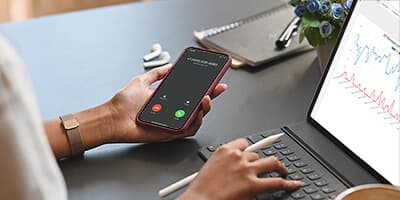
ClearIP supports branded calling to optimize call completion and call back. Voice service providers can make branded calling available to customers who are looking for ways to increase the value they gain from their communication services.
CNAM
ClearIP provides CNAM caller ID name information. This service can be enabled per DID, should you wish to offer this as an add-on service to subscribers.
As with all ClearIP services, CNAM isn’t all-or-nothing. You can enable CNAM for some calls and not others. This is helpful when dealing with multiple providers who offer CNAM at different rates.
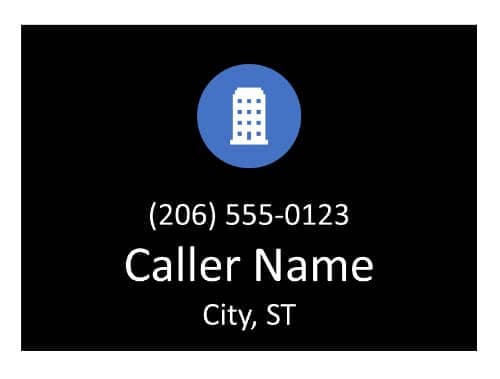
Integration
ClearIP integrates with SIP devices using standard SIP (Session Initiation Protocol) signaling. These messages can be exchanged directly or through a proxy:
- TLS proxy provides additional encryption security.
- Inline proxy is used by some ClearIP customers because it makes deployment easier with their telecom network equipment and software.
Simply create a SIP trunk pointing to ClearIP and put it at the top of your routing table. Your network will send SIP INVITEs to ClearIP as if it were a normal SIP trunk.
ClearIP will perform the services configured for the call and return a standard SIP message to the device so that it either allows, diverts or blocks the call.
The following diagrams illustrate typical configurations and call flows for integration with SIP devices for inbound, outbound, and outbound calls with routing. Depending upon your needs, your configuration may differ from these examples.
Show diagrams for the selected platform:
Click each tab for more information.

When an inbound call is checked for robocalling. ClearIP will return to the peering SBC either a:
- SIP 302, robocalling or TDoS detected with diversion enabled. ClearIP will return the configured diversion destination, typically voicemail or a CAPTCHA device, which prompts for human interaction.
- SIP 503, neither robocalling nor TDoS detected, allow the call. The SBC will route advance to the switch.
- SIP 603, robocalling or TDoS detected. The SBC will block the call before it reaches the switch or called party.
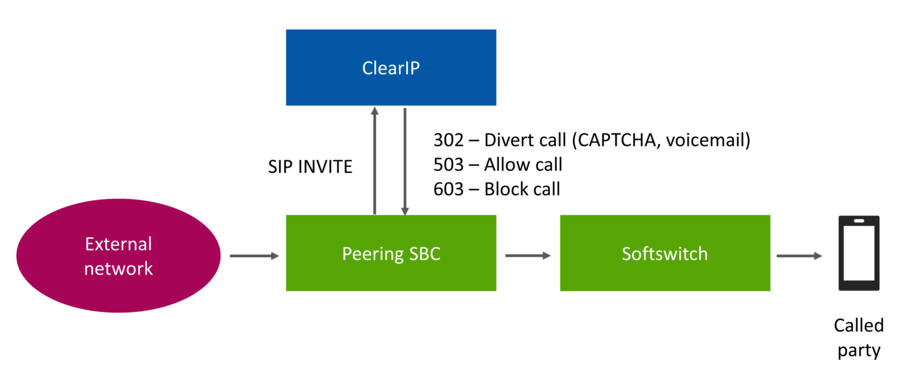
SIP ladders
- Robocall detected. Divert the call to CAPTCHA with a SIP 302. User response successful. Allow the call.
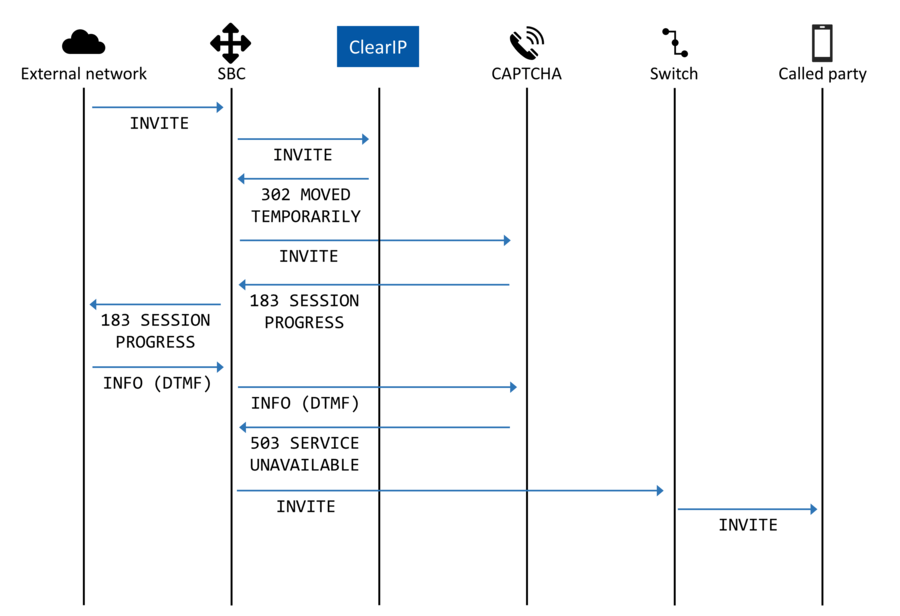
- Robocall detected. Divert the call to CAPTCHA with a SIP 302. User response failed. Block the call.
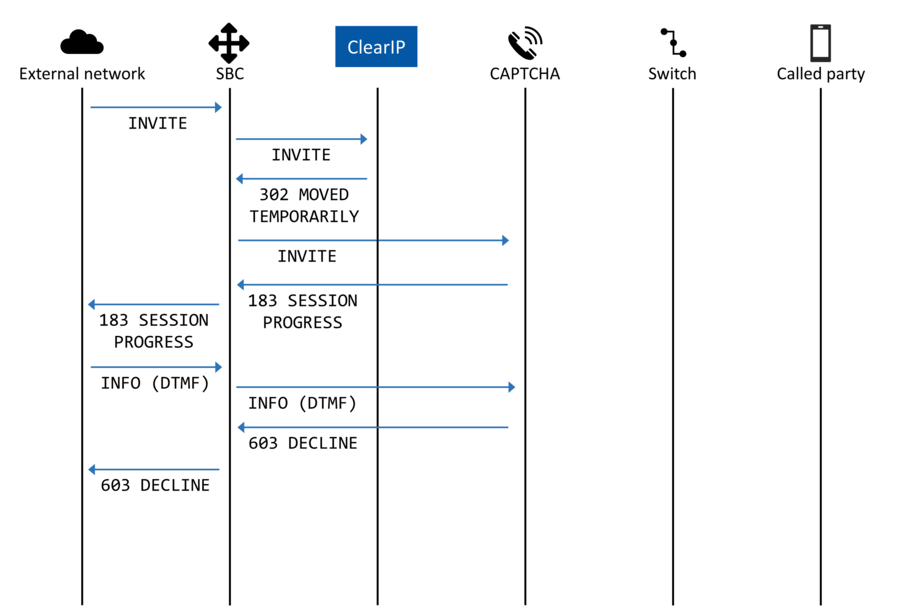
- Neither robocall nor TDoS detected. Allow the call with a SIP 503
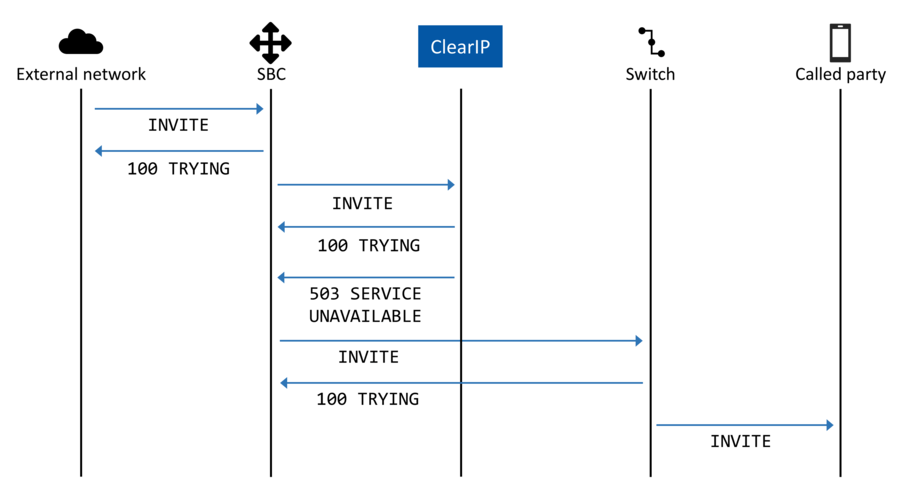
- Robocall or TDoS detected. Block the call with a SIP 603
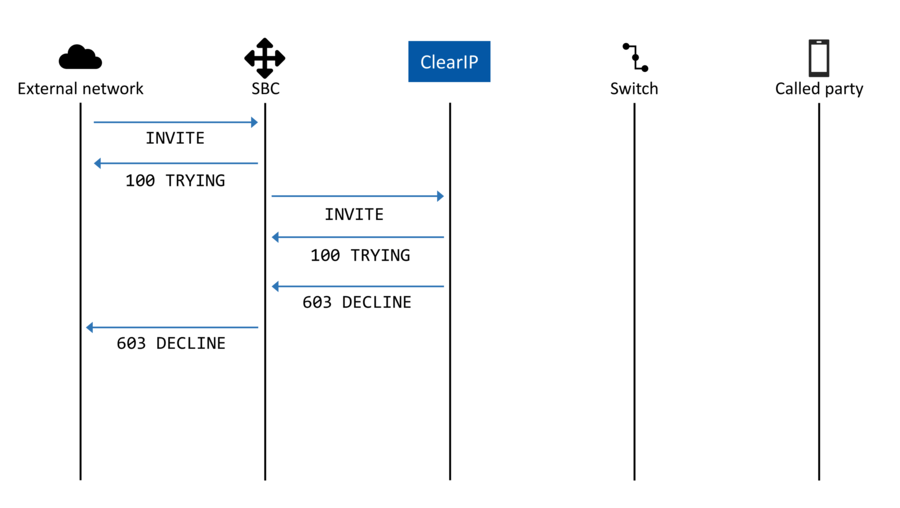
When an inbound call is checked for robocalling. ClearIP will return to the 2600Hz Kazoo either a:
- SIP 302, robocalling or TDoS detected with diversion enabled. ClearIP will return the configured diversion destination, typically voicemail or a CAPTCHA device, which prompts for human interaction.
- SIP 503, neither robocalling nor TDoS detected, allow the call. The Kazoo will route the call to the called party.
- SIP 603, robocalling or TDoS detected. The Kazoo will block the call before it reaches the switch or called party.
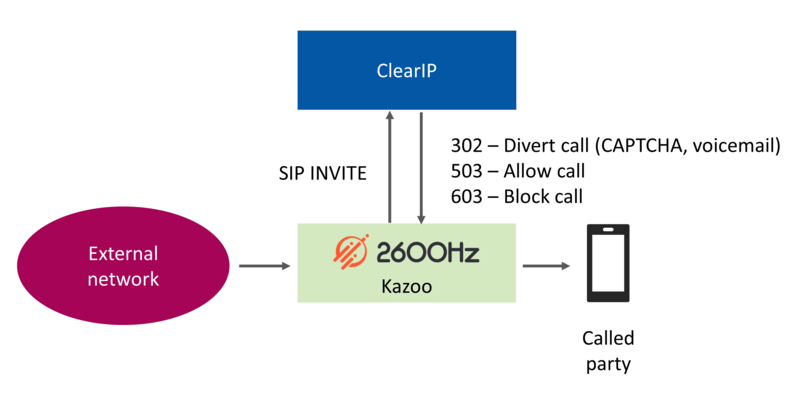
When an inbound call is checked for robocalling. ClearIP will return to the Asterisk IP PBX either a:
- SIP 302, robocalling or TDoS detected with diversion enabled. ClearIP will return the configured diversion destination, typically voicemail or a CAPTCHA device, which prompts for human interaction.
- SIP 503, neither robocalling nor TDoS detected, allow the call. The Asterisk will route the call to the called party.
- SIP 603, robocalling or TDoS detected. The Asterisk will block the call before it reaches the called party.
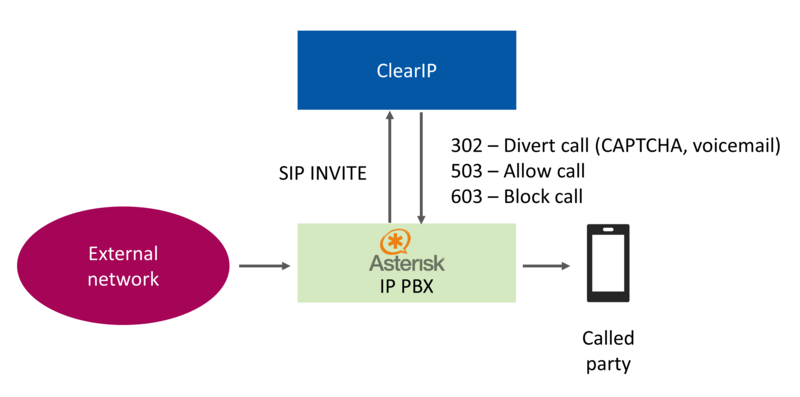
Asterisk STIR/SHAKEN and CNAM configuration with ClearIP
Asterisk with ClearIP In-Line Proxy for routing and STIR/SHAKEN
When an inbound call is checked for robocalling. ClearIP will return to the AudioCodes Mediant SBC either a:
- SIP 302, robocalling or TDoS detected with diversion enabled. ClearIP will return the configured diversion destination, typically voicemail or a CAPTCHA device, which prompts for human interaction.
- SIP 503, neither robocalling nor TDoS detected, allow the call. The Mediant SBC will route advance to the switch.
- SIP 603, robocalling or TDoS detected. The Mediant SBC will block the call before it reaches the switch or called party.
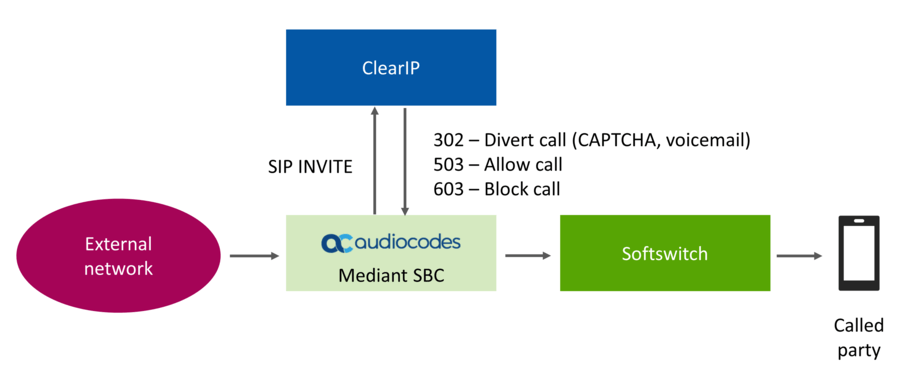
See AudioCodes documentation for more information on configuring their SBC for integration with ClearIP.
When an inbound call is checked for robocalling. ClearIP will return to the Avaya SBC either a:
- SIP 302, robocalling or TDoS detected with diversion enabled. ClearIP will return the configured diversion destination, typically voicemail or a CAPTCHA device, which prompts for human interaction.
- SIP 503, neither robocalling nor TDoS detected, allow the call. The SBCE will route advance to the switch.
- SIP 603, robocalling or TDoS detected. The SBCE will block the call before it reaches the switch or called party.
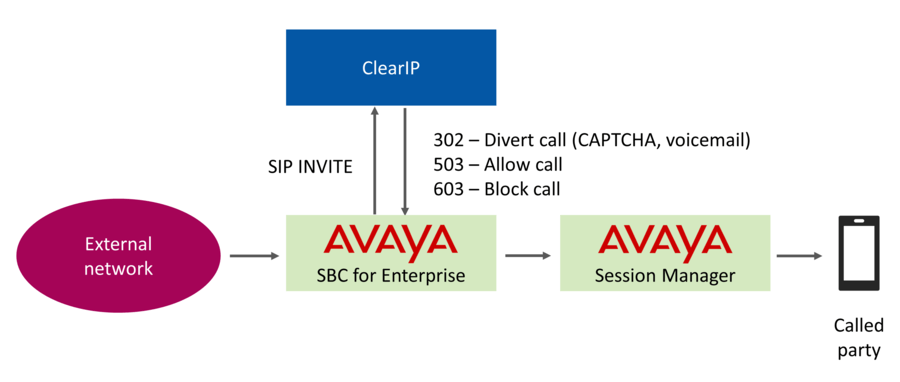
When an inbound call is checked for robocalling. ClearIP will return to the peering SBC either a:
- SIP 302, robocalling or TDoS detected with diversion enabled. ClearIP will return the configured diversion destination, typically voicemail or a CAPTCHA device, which prompts for human interaction.
- SIP 503, neither robocalling nor TDoS detected, allow the call. The peering SBC will route advance to the BroadWorks.
- SIP 603, robocalling or TDoS detected. The peering SBC will block the call before it reaches the BroadWorks or called party.
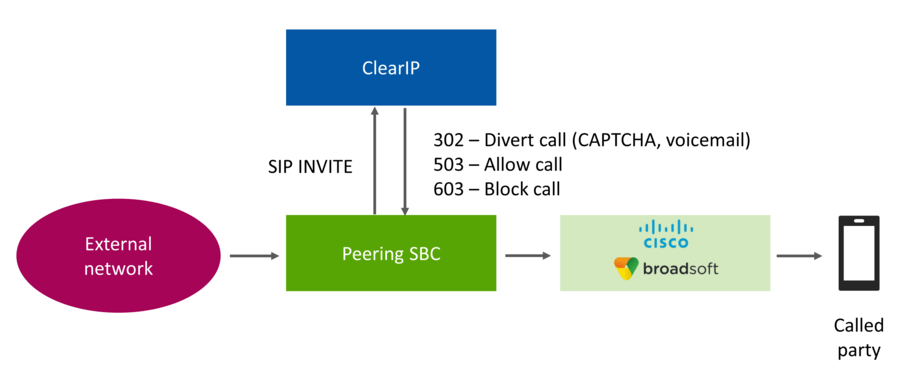
When an inbound call is checked for robocalling. ClearIP will return to the Cisco CUBE either a:
- SIP 302, robocalling or TDoS detected with diversion enabled. ClearIP will return the configured diversion destination, typically voicemail or a CAPTCHA device, which prompts for human interaction.
- SIP 503, neither robocalling nor TDoS detected, allow the call. The CUBE will route advance to the switch.
- SIP 603, robocalling or TDoS detected. The CUBE will block the call before it reaches the switch or called party.
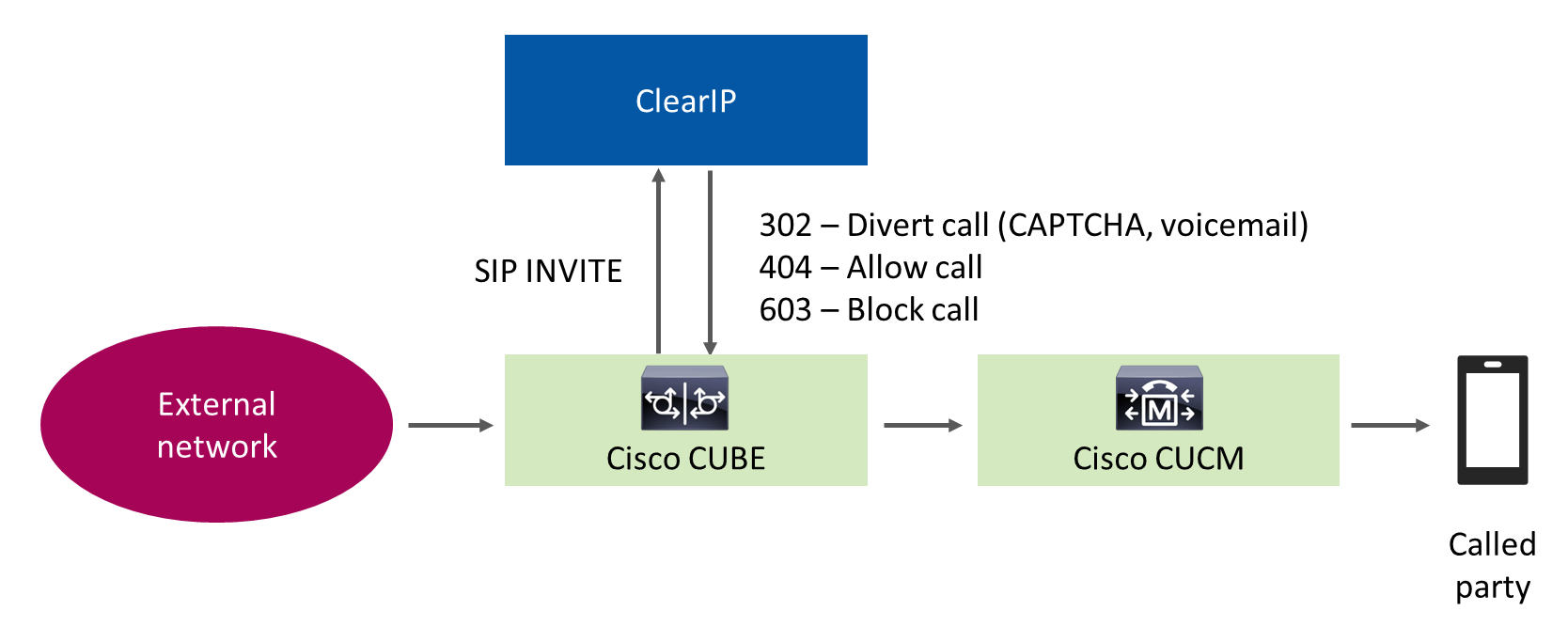
When an inbound call is checked for robocalling. ClearIP will return to the FreeSWITCH either a:
- SIP 302, robocalling or TDoS detected with diversion enabled. ClearIP will return the configured diversion destination, typically voicemail or a CAPTCHA device, which prompts for human interaction.
- SIP 503, neither robocalling nor TDoS detected, allow the call. The FreeSWITCH will route advance to the switch.
- SIP 603, robocalling or TDoS detected. The ingress SBC will block the call before it reaches the switch or called party.
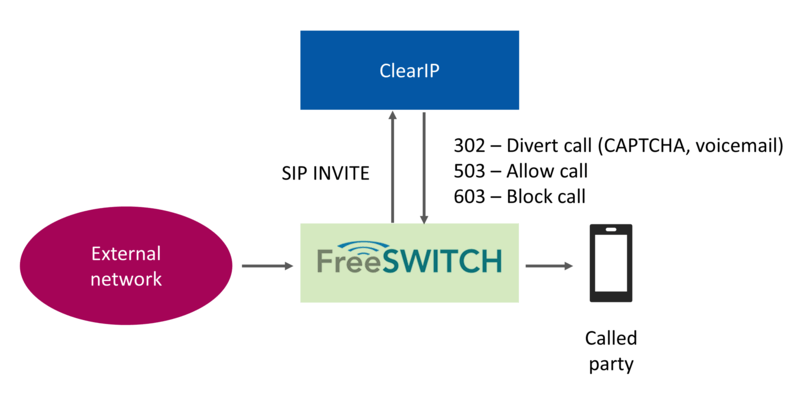
When an inbound call is checked for robocalling. ClearIP will return to the Kamailio SIP Server either a:
- SIP 302, robocalling or TDoS detected with diversion enabled. ClearIP will return the configured diversion destination, typically voicemail or a CAPTCHA device, which prompts for human interaction.
- SIP 503, neither robocalling nor TDoS detected, allow the call. The Kamailio will route advance to the switch.
- SIP 603, robocalling or TDoS detected. The Kamailio will block the call before it reaches the switch or called party.
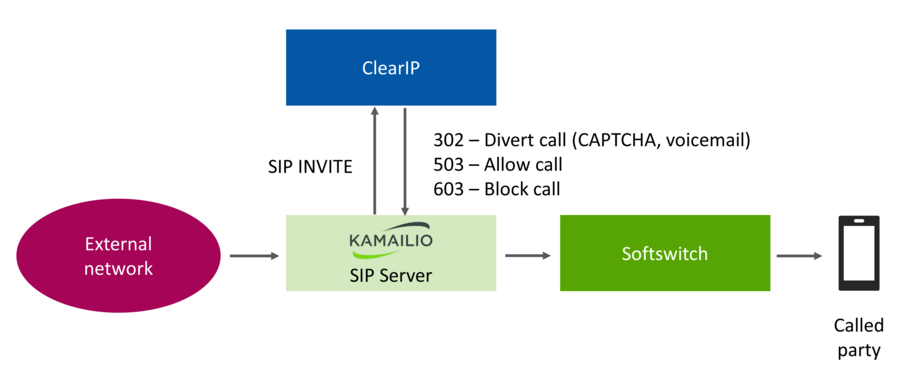
When an inbound call is checked for robocalling. ClearIP will return to the Metasphere CFS either a:
- SIP 302, robocalling or TDoS detected with diversion enabled. ClearIP will return the configured diversion destination, typically voicemail or a CAPTCHA device, which prompts for human interaction.
- SIP 404, neither robocalling nor TDoS detected, allow the call. The Metasphere CFS will route advance to allow the call.
- SIP 603, robocalling or TDoS detected. The Metasphere CFS will block the call before it reaches the called party.
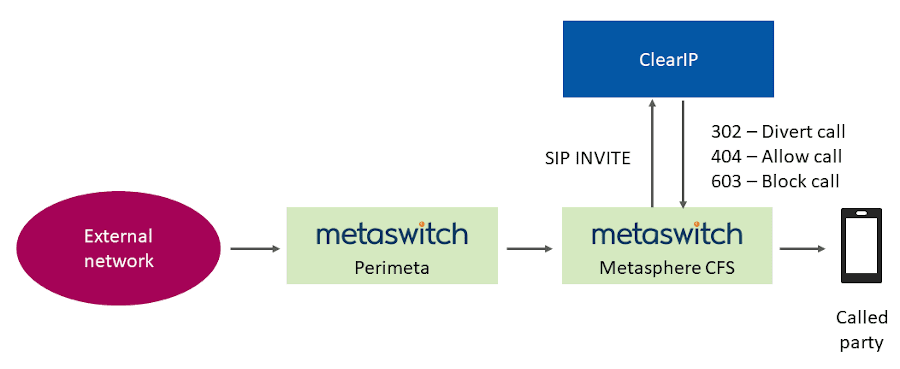
We have provided Metaswitch inbound configuration instructions for ClearIP for use cases where there is no Enhanced Application Server providing terminating subscriber services. We have also provided Metaswitch inbound configuration with EAS instructions for ClearIP in cases where an Enhanced Application Server is present and is providing terminating subscriber services.
When an inbound call is checked for robocalling. ClearIP will return to the Metaswitch Perimeta SBC either a:
- SIP 302, robocalling or TDoS detected with diversion enabled. ClearIP will return the configured diversion destination, typically voicemail or a CAPTCHA device, which prompts for human interaction.
- SIP 503, neither robocalling nor TDoS detected, allow the call. The Perimeta will route advance to the switch.
- SIP 603, robocalling or TDoS detected. The Perimeta will block the call before it reaches the switch or called party.

When an inbound call is checked for robocalling. ClearIP will return to the SBC or SIP Proxy either a:
- SIP 302, robocalling or TDoS detected with diversion enabled. ClearIP will return the configured diversion destination, typically voicemail or a CAPTCHA device, which prompts for human interaction.
- SIP 503, neither robocalling nor TDoS detected, allow the call. The SBC or SIP Proxy will route advance to the switch.
- SIP 603, robocalling or TDoS detected. The SBC or SIP Proxy will block the call before it reaches the switch or called party.
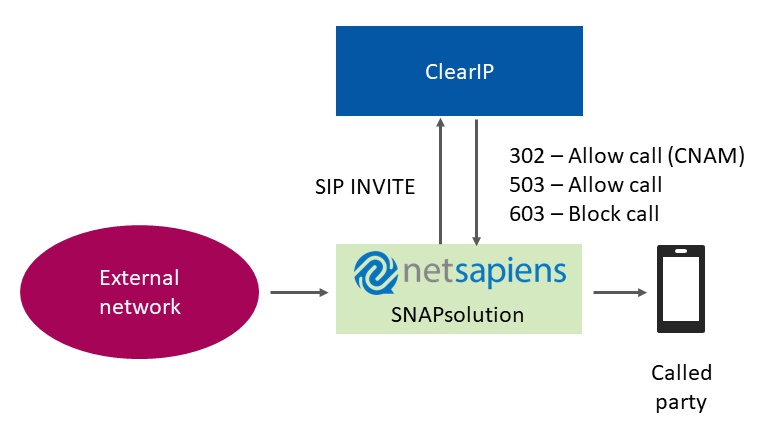
See NetSapiens documentation for more information on configuring their SNAPsolution for integration with ClearIP (login credentials required).
When an inbound call is checked for robocalling. ClearIP will return to the Oracle Acme Packet SBC either a:
- SIP 302, robocalling or TDoS detected with diversion enabled. ClearIP will return the configured diversion destination, typically voicemail or a CAPTCHA device, which prompts for human interaction.
- SIP 503, neither robocalling nor TDoS detected, allow the call. The Acme Packet will route advance to the switch.
- SIP 603, robocalling or TDoS detected. The Acme Packet will block the call before it reaches the switch or called party.
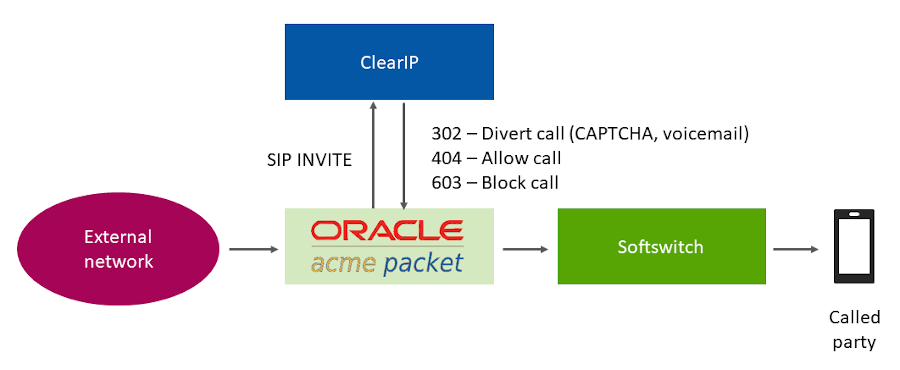
When an inbound call is checked for robocalling. ClearIP will return to the PortaSwitch either a:
- SIP 302, robocalling or TDoS detected with diversion enabled. ClearIP will return the configured diversion destination, typically voicemail or a CAPTCHA device, which prompts for human interaction.
- SIP 503, neither robocalling nor TDoS detected, allow the call. The PortaSwitch will route advance.
- SIP 603, robocalling or TDoS detected. The PortaSwitch will block the call before it reaches the switch or called party.
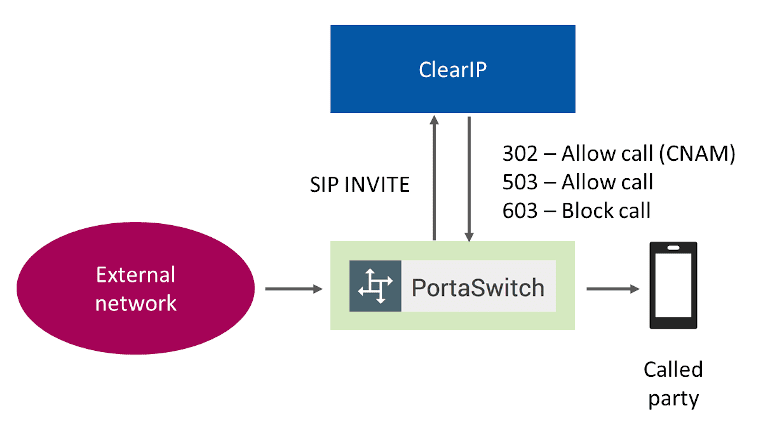
When an inbound call is checked for robocalling. ClearIP will return to the peering SBC either a:
- SIP 302, robocalling or TDoS detected with diversion enabled. ClearIP will return the configured diversion destination, typically voicemail or a CAPTCHA device, which prompts for human interaction.
- SIP 503, neither robocalling nor TDoS detected, allow the call. The peering SBC will route advance to the Ribbon Call Controller.
- SIP 603, robocalling or TDoS detected. The peering SBC will block the call before it reaches the Ribbon Call Controller or called party.
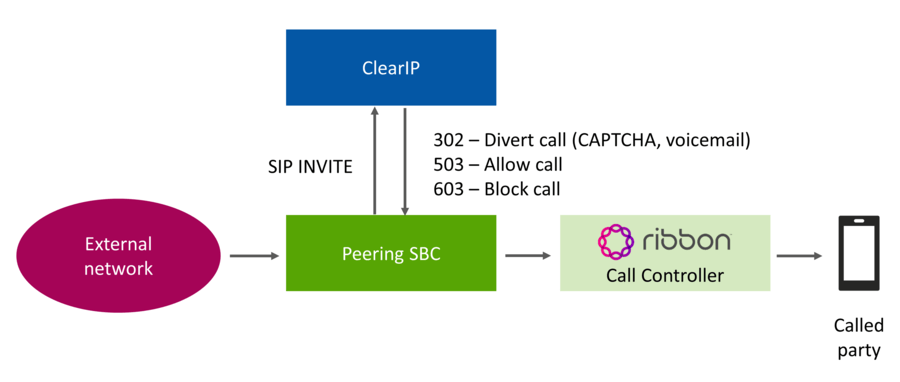
When an inbound call is checked for robocalling. ClearIP will return to the Ribbon SBC either a:
- SIP 302, robocalling or TDoS detected with diversion enabled. ClearIP will return the configured diversion destination, typically voicemail or a CAPTCHA device, which prompts for human interaction.
- SIP 503, neither robocalling nor TDoS detected, allow the call. The SBC will route advance to the switch.
- SIP 603, robocalling or TDoS detected. The SBC will block the call before it reaches the switch or called party.
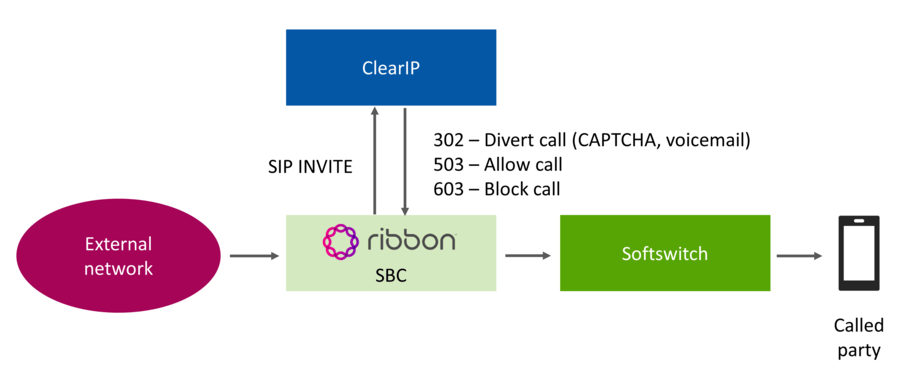
When an inbound call is checked for robocalling. ClearIP will return to the Sansay VSXi SBC either a:
- SIP 302, robocalling or TDoS detected with diversion enabled. ClearIP will return the configured diversion destination, typically voicemail or a CAPTCHA device, which prompts for human interaction.
- SIP 503, neither robocalling nor TDoS detected, allow the call. The VSXi will route advance to the switch.
- SIP 603, robocalling or TDoS detected. The VSXi will block the call before it reaches the switch or called party.
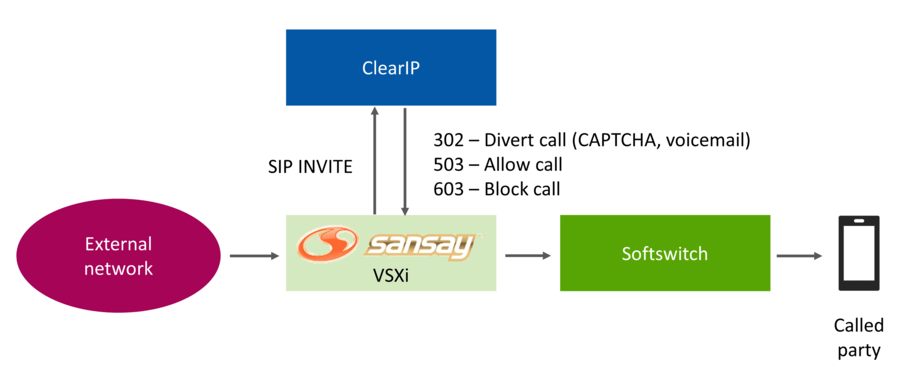
When an inbound call is checked for robocalling. ClearIP will return to the TelcoBridges FreeSBC/ProSBC either a:
- SIP 302, robocalling or TDoS detected with diversion enabled. ClearIP will return the configured diversion destination, typically voicemail or a CAPTCHA device, which prompts for human interaction.
- SIP 503, neither robocalling nor TDoS detected, allow the call. The FreeSBC/ProSBC will route advance to the softswitch.
- SIP 603, robocalling or TDoS detected. The FreeSBC/ProSBC will block the call before it reaches the softswitch or called party.
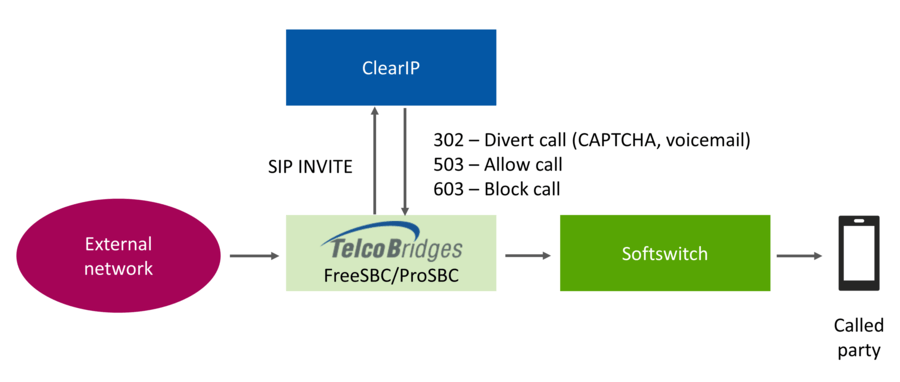
See TelcoBridges documentation for more information on configuring their SBC for integration with ClearIP:
- ProSBC Configuration for STIR/SHAKEN with TransNexus ClearIP service
- ProSBC Configuration for Robocall Mitigation with TransNexus ClearIP service
When an outbound call is checked for fraud, ClearIP will return to the peering SBC either a:
- SIP 503, no fraud detected, allow the call. The SBC will route advance to the next destination in its local routing table
- SIP 603, fraud detected, block the call.
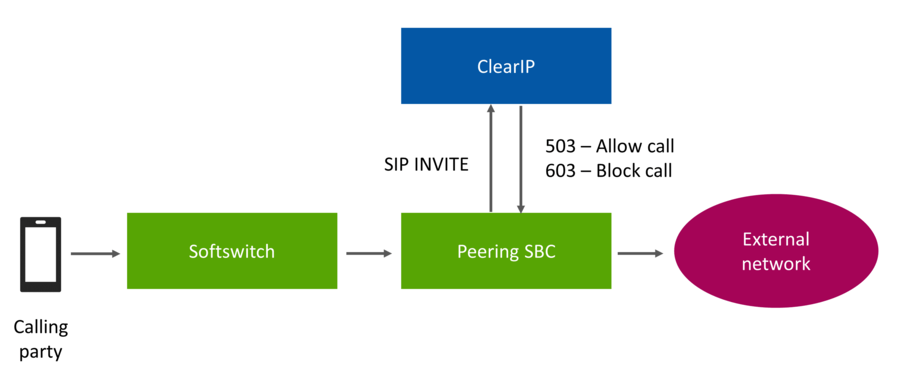
SIP ladders
When an outbound call is checked for fraud, ClearIP will return to the 2600Hz Kazoo either a:
- SIP 503, no fraud detected, allow the call. The Kazoo will route advance to the next destination in its local routing table
- SIP 603, fraud detected, block the call.
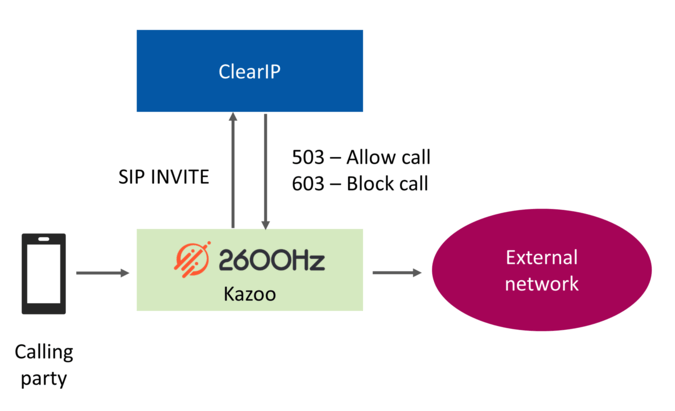
When an outbound call is checked for fraud, ClearIP will return to the Asterisk IP PBX either a:
- SIP 503, no fraud detected, allow the call. The Asterisk will route advance to the next destination in its local routing table
- SIP 603, fraud detected, block the call.
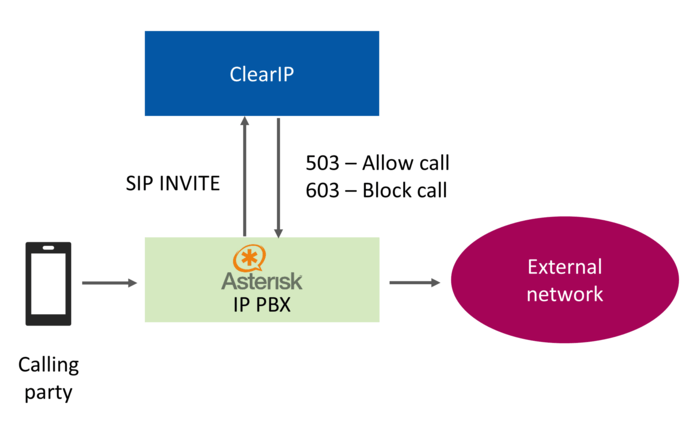
Asterisk STIR/SHAKEN and CNAM configuration with ClearIP
Asterisk with ClearIP In-Line Proxy for routing and STIR/SHAKEN
When an outbound call is checked for fraud, ClearIP will return to the AudioCodes Mediant SBC either a:
- SIP 503, no fraud detected, allow the call. The Mediant SBC will route advance to the next destination in its local routing table
- SIP 603, fraud detected, block the call.
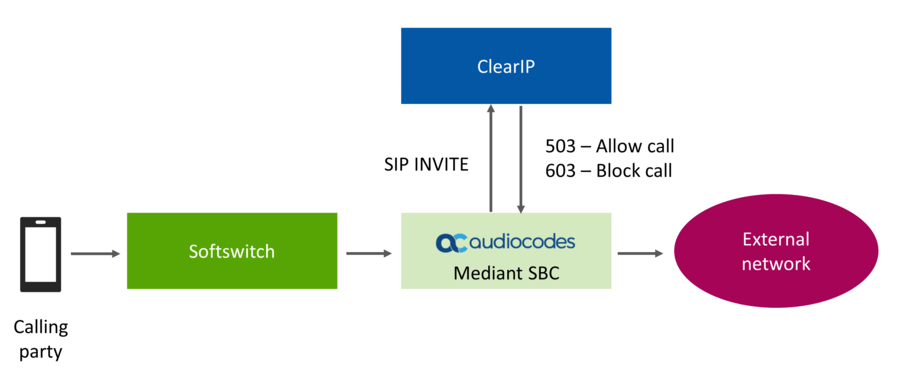
See AudioCodes documentation for more information on configuring their SBC for integration with ClearIP.
When an outbound call is checked for fraud, ClearIP will return to the Avaya Session Manager either a:
- SIP 503, no fraud detected, allow the call. The Session Manager will route advance to the next destination in its local routing table
- SIP 603, fraud detected, block the call.
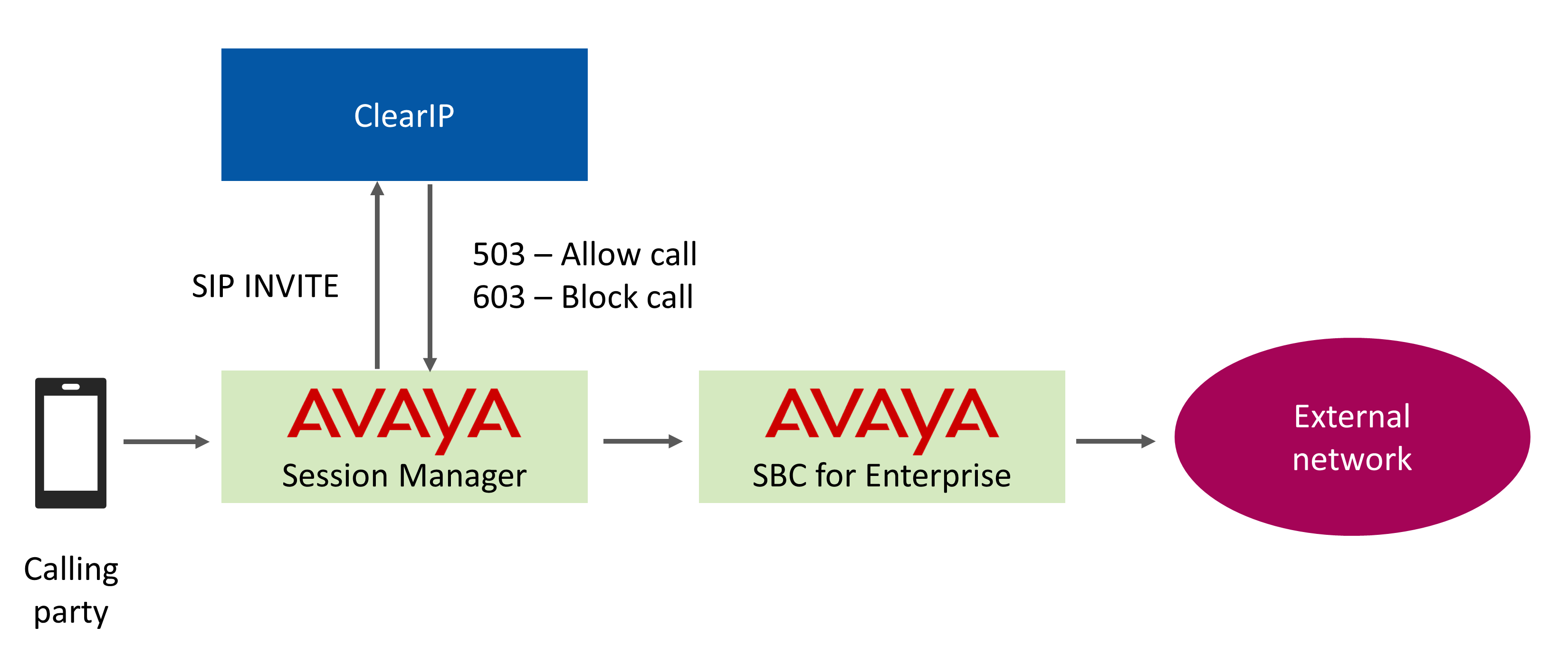
When an outbound call is checked for fraud, ClearIP will return to the BroadWorks either a:
- SIP 503, no fraud detected, allow the call. The BroadWorks will route advance to the next destination in its local routing table
- SIP 603, fraud detected, block the call.
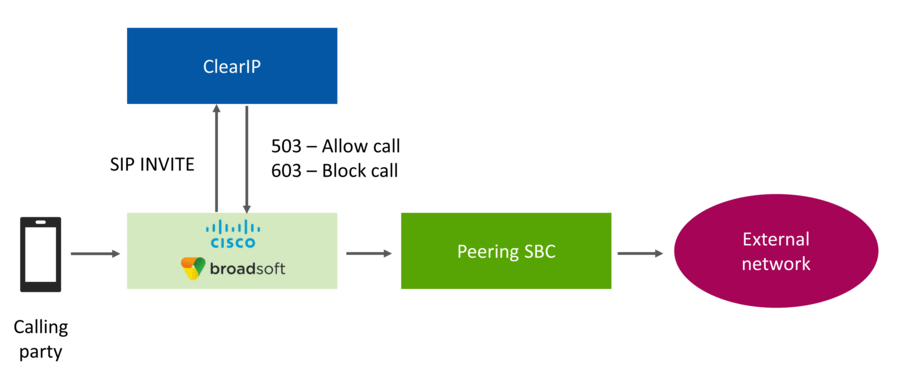
When an outbound call is checked for fraud, ClearIP will return to the Communications Manager either a:
- SIP 503, no fraud detected, allow the call. The CUCM will route advance to the next destination in its local routing table
- SIP 603, fraud detected, block the call.
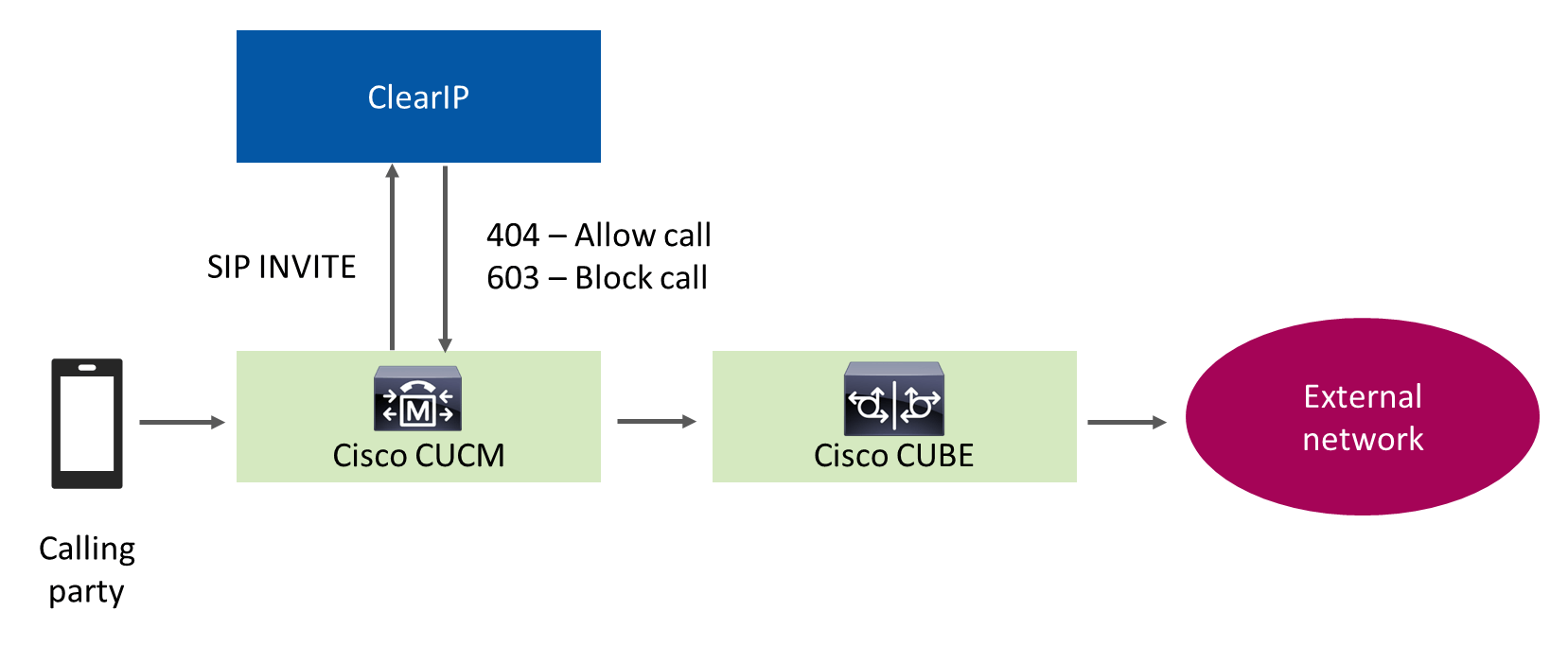
When an outbound call is checked for fraud, ClearIP will return to the FreeSWITCH either a:
- SIP 503, no fraud detected, allow the call. The FreeSWITCH will route advance to the next destination in its local routing table
- SIP 603, fraud detected, block the call.
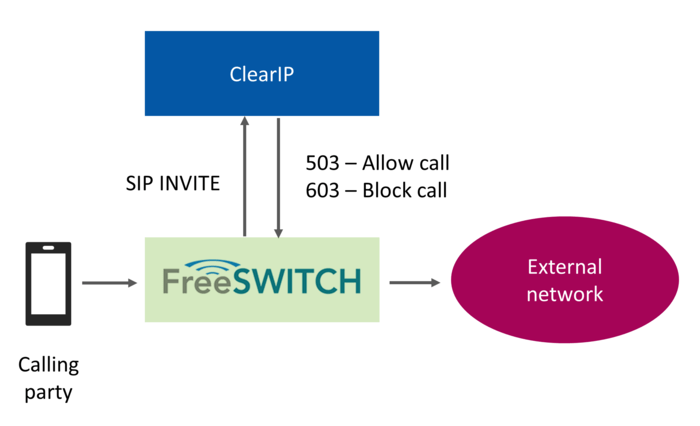
When an outbound call is checked for fraud, ClearIP will return to the Kamailio SIP Server either a:
- SIP 503, no fraud detected, allow the call. The Kamailio will route advance to the next destination in its local routing table
- SIP 603, fraud detected, block the call.
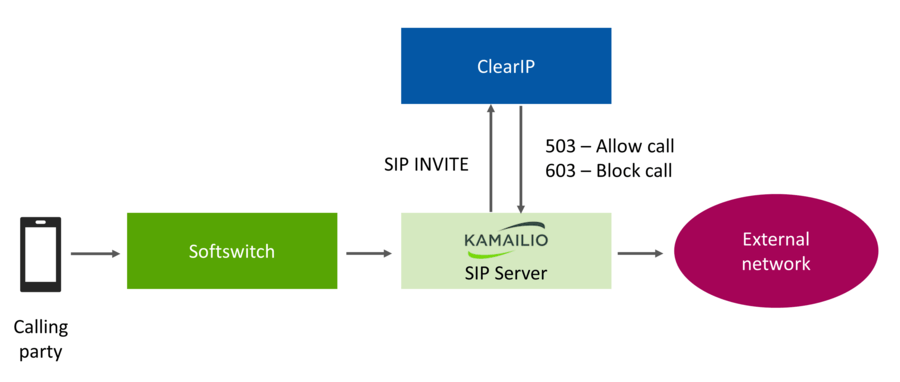
When an outbound call is checked for fraud, ClearIP will return to the Metasphere CFS either a:
- SIP 404, no fraud detected, allow the call. The Metasphere CFS will route advance to the next destination in its local routing table
- SIP 603, fraud detected, block the call.
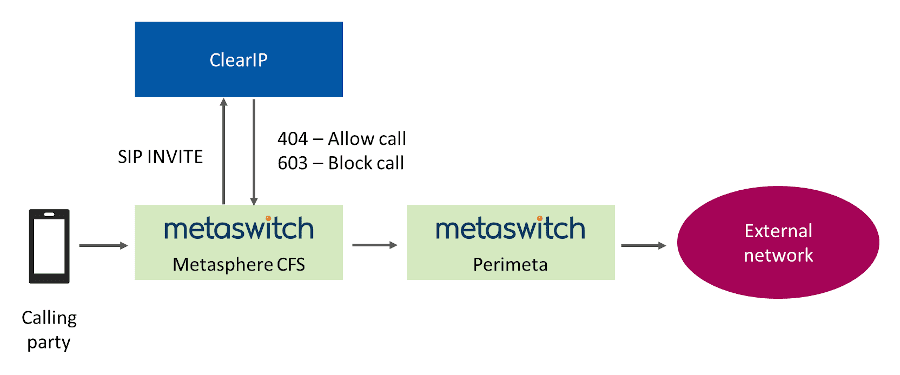
We have provided Metaswitch outbound configuration instructions for ClearIP.
When an outbound call is checked for fraud, ClearIP will return to the Metaswitch Perimeta SBC either a:
- SIP 503, no fraud detected, allow the call. The Perimeta will route advance to the next destination in its local routing table
- SIP 603, fraud detected, block the call.
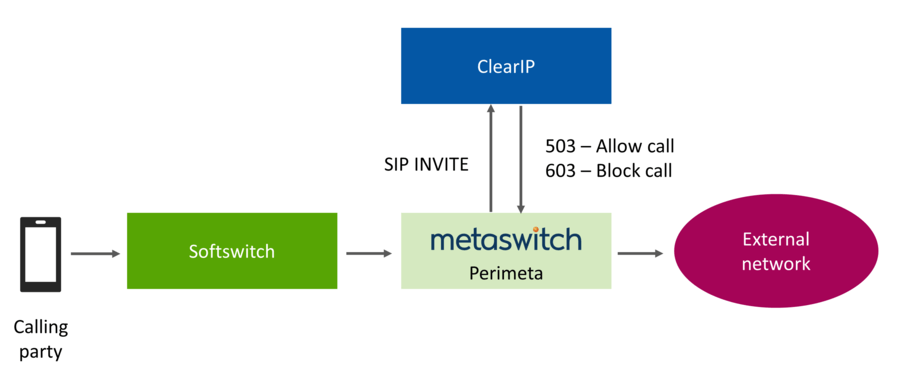
When an outbound call is checked for fraud, ClearIP will return to the netsapiens either a:
- SIP 503, no fraud detected, allow the call. The netsapiens will route advance to the next destination in its local routing table
- SIP 603, fraud detected, block the call.
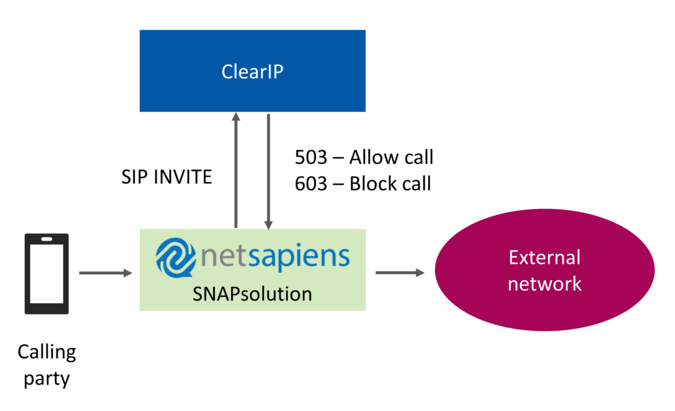
See NetSapiens documentation for more information on configuring their SNAPsolution for integration with ClearIP (login credentials required).
When an outbound call is checked for fraud, ClearIP will return to the Oracle Acme Packet SBC either a:
- SIP 404, no fraud detected, allow the call. The Acme Packet will route advance to the next destination in its local routing table
- SIP 603, fraud detected, block the call.
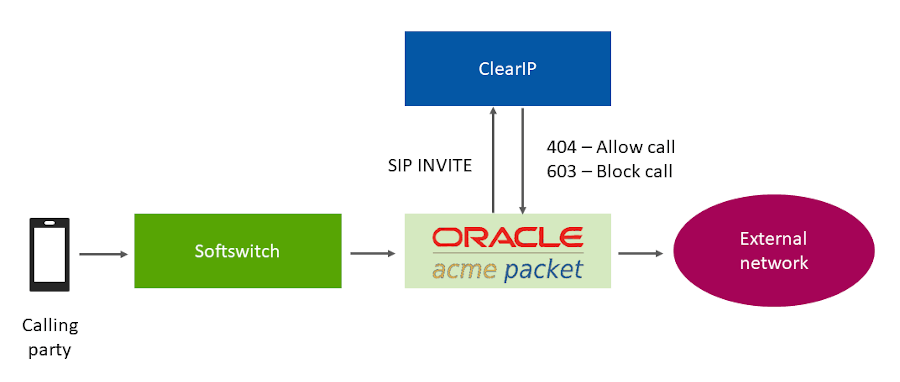
When an outbound call is checked for fraud, ClearIP will return to the PortaSwitch either a:
- SIP 503, no fraud detected, allow the call. The PortaSwitch will route advance to the next destination in its local routing table
- SIP 603, fraud detected, block the call.
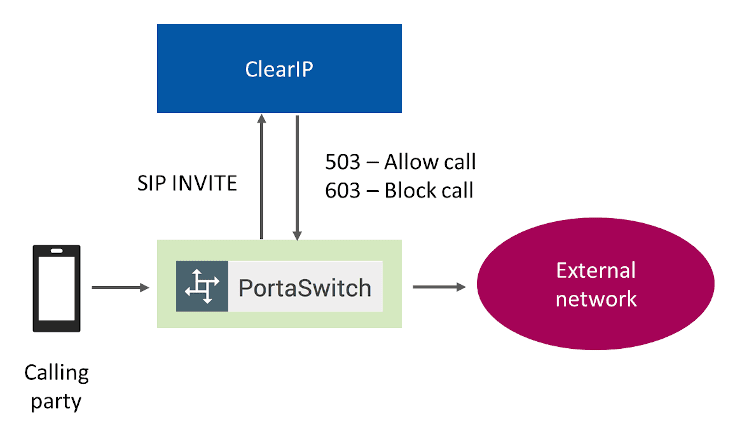
When an outbound call is checked for fraud, ClearIP will return to the Ribbon Call Controller either a:
- SIP 503, no fraud detected, allow the call. The Ribbon Call Controller will route advance to the next destination in its local routing table
- SIP 603, fraud detected, block the call.
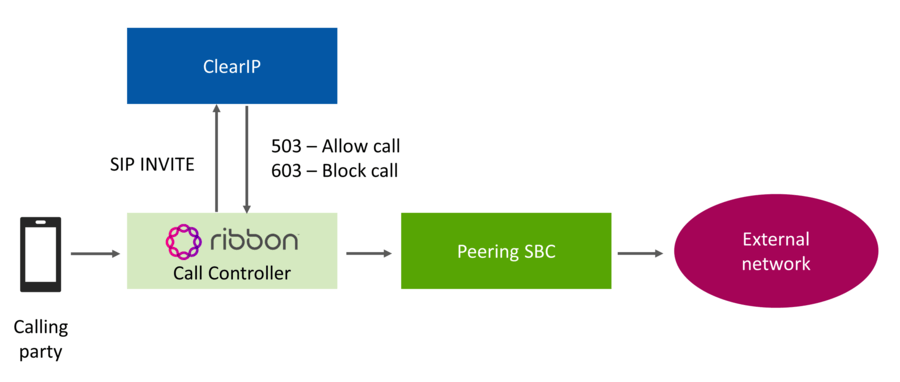
When an outbound call is checked for fraud, ClearIP will return to the Ribbon SBC either a:
- SIP 503, no fraud detected, allow the call. The SBC will route advance to the next destination in its local routing table
- SIP 603, fraud detected, block the call.
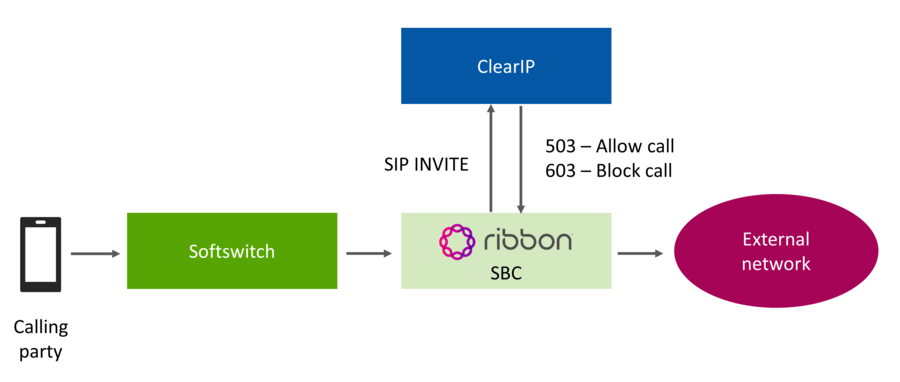
When an outbound call is checked for fraud, ClearIP will return to the Sansay VSXi SBC either a:
- SIP 503, no fraud detected, allow the call. The VSXi will route advance to the next destination in its local routing table
- SIP 603, fraud detected, block the call.
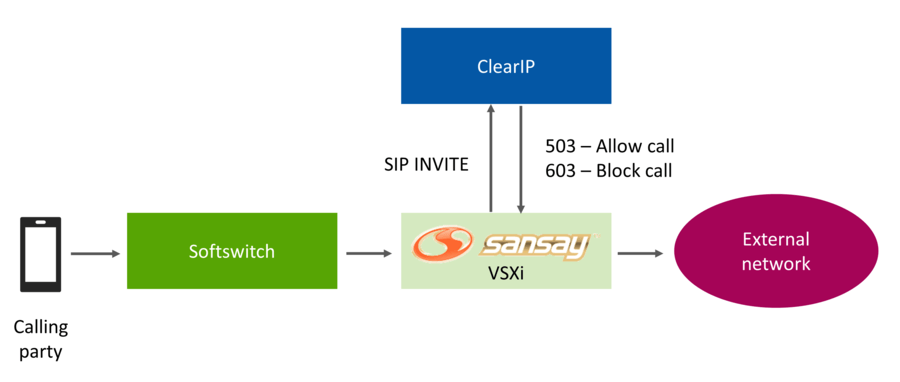
When an outbound call is checked for fraud, ClearIP will return to the TelcoBridges FreeSBC/ProSBC either a:
- SIP 503, no fraud detected, allow the call. The FreeSBC/ProSBC will route advance to the next destination in its local routing table
- SIP 603, fraud detected, block the call.
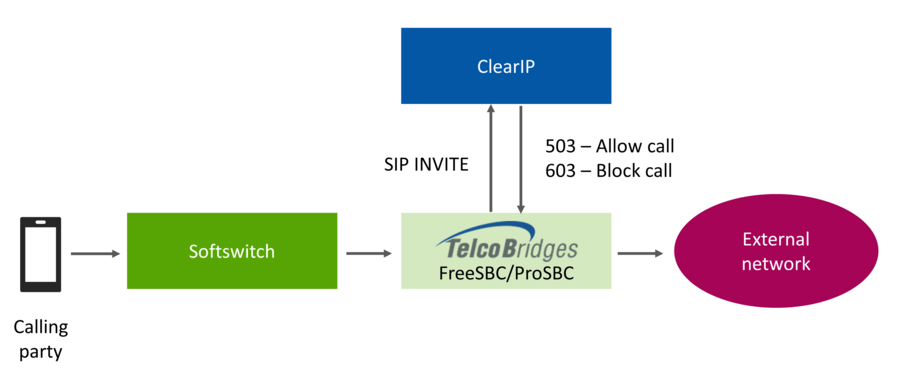
See TelcoBridges documentation for more information on configuring their SBC for integration with ClearIP:
- ProSBC Configuration for STIR/SHAKEN with TransNexus ClearIP service
- ProSBC Configuration for Robocall Mitigation with TransNexus ClearIP service
When an outbound call is checked for routing, ClearIP will return to the peering SBC either a:
- SIP 302 with a list of routes in the contact header
- SIP 603 if the call is to be blocked as a result of any other ClearIP service (e.g., fraud prevention, STIR/SHAKEN).
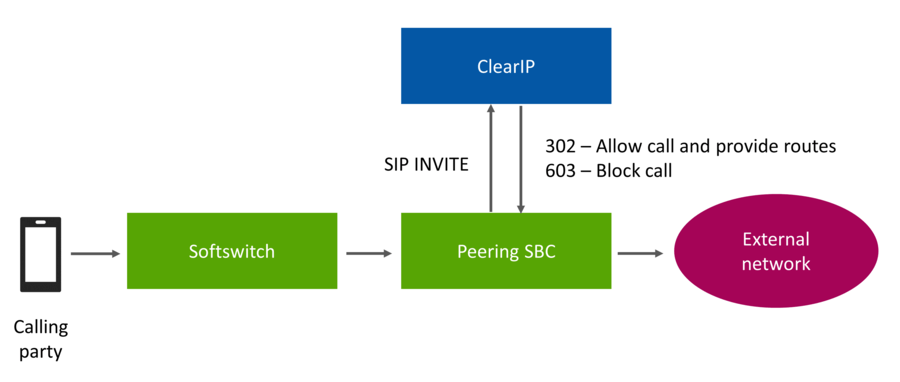
SIP ladders
When an outbound call is checked for routing, ClearIP will return to the SIP Proxy either a:
- SIP 302 with a list of routes in the contact header
- SIP 603 if the call is to be blocked as a result of any other ClearIP service analysis (e.g., fraud prevention, STIR/SHAKEN).
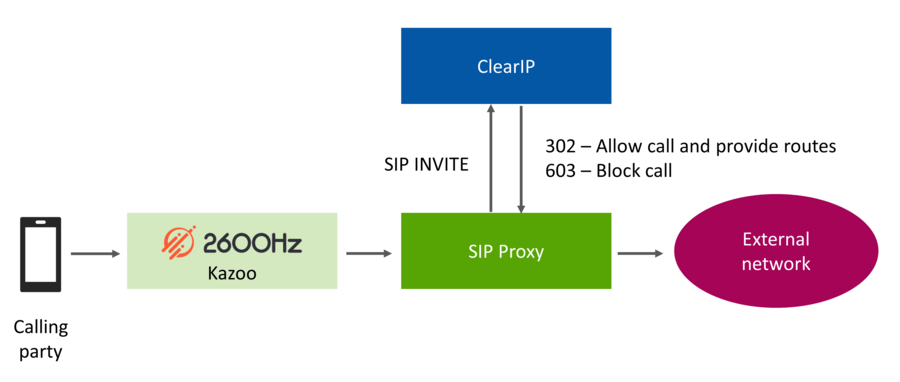
When an outbound call is checked for routing, ClearIP will return to the Asterisk IP PBX either a:
- SIP 302 with a list of routes in the contact header
- SIP 603 if the call is to be blocked as a result of any other ClearIP service analysis (e.g., fraud prevention, STIR/SHAKEN).
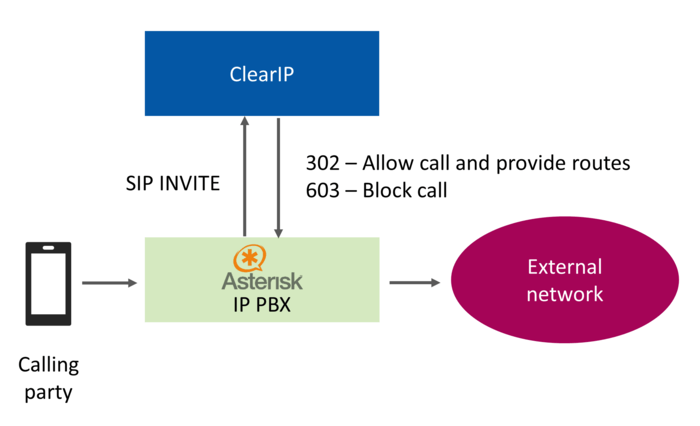
Asterisk STIR/SHAKEN and CNAM configuration with ClearIP
Asterisk with ClearIP In-Line Proxy for routing and STIR/SHAKEN
When an outbound call is checked for routing, ClearIP will return to the AudioCodes Mediant SBC either a:
- SIP 302 with a list of routes in the contact header
- SIP 603 if the call is to be blocked as a result of any other ClearIP service analysis (e.g., fraud prevention, STIR/SHAKEN).
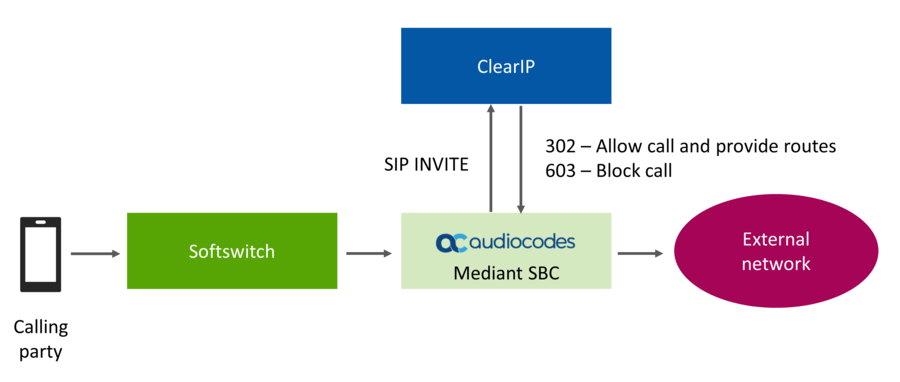
See AudioCodes documentation for more information on configuring their SBC for integration with ClearIP.
When an outbound call is checked for routing, ClearIP will return to the Avaya Session Manager either a:
- SIP 302 with a list of routes in the contact header
- SIP 603 if the call is to be blocked as a result of any other ClearIP service analysis (e.g., fraud prevention, STIR/SHAKEN).
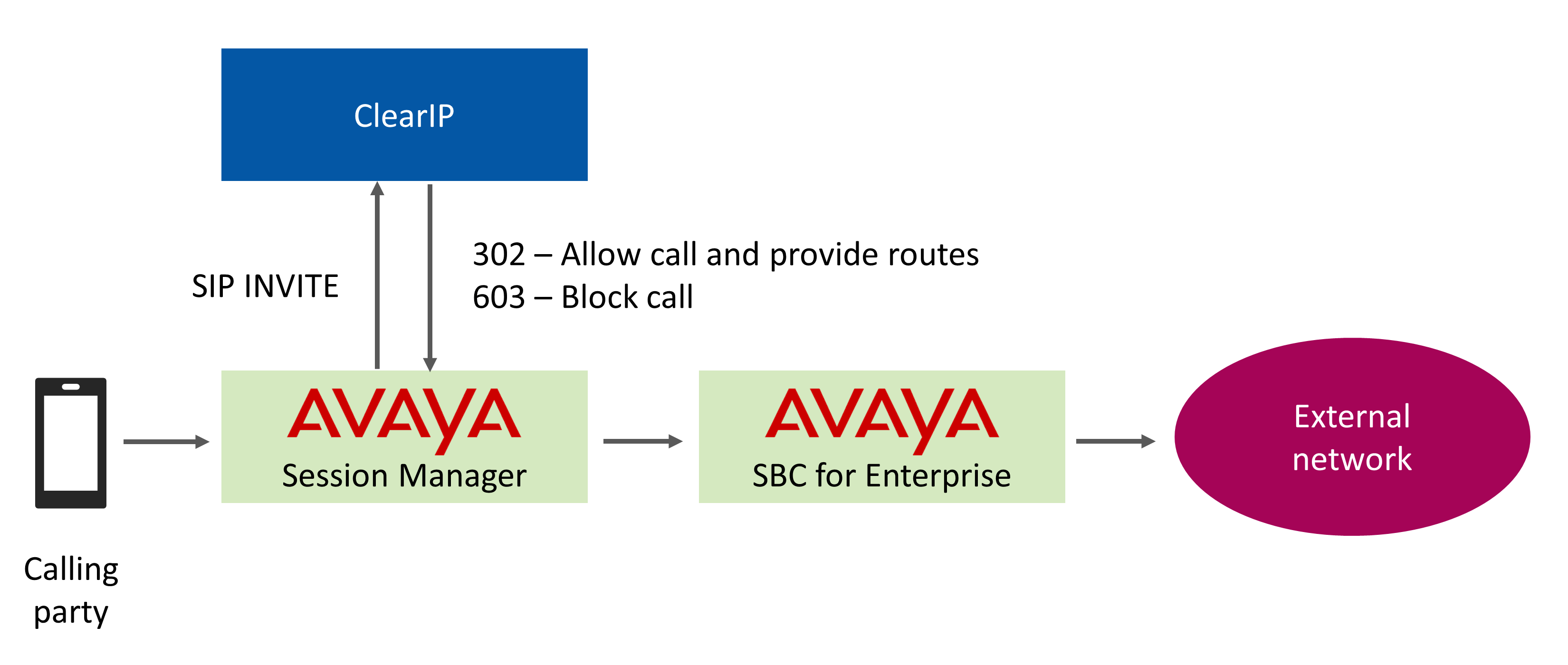
When an outbound call is checked for routing, ClearIP will return to the BroadWorks either a:
- SIP 302 with a list of routes in the contact header
- SIP 603 if the call is to be blocked as a result of any other ClearIP service analysis (e.g., fraud prevention, STIR/SHAKEN).
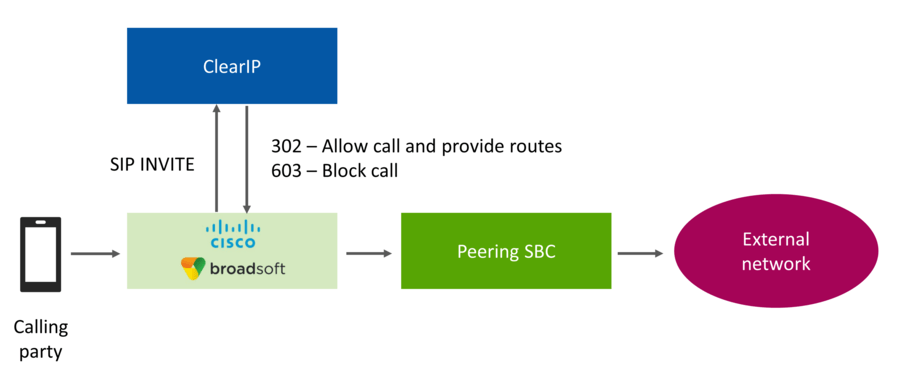
When an outbound call is checked for routing, ClearIP will return to the Communications Manager either a:
- SIP 302 with a list of routes in the contact header
- SIP 603 if the call is to be blocked as a result of any other ClearIP service analysis (e.g., fraud prevention, STIR/SHAKEN).
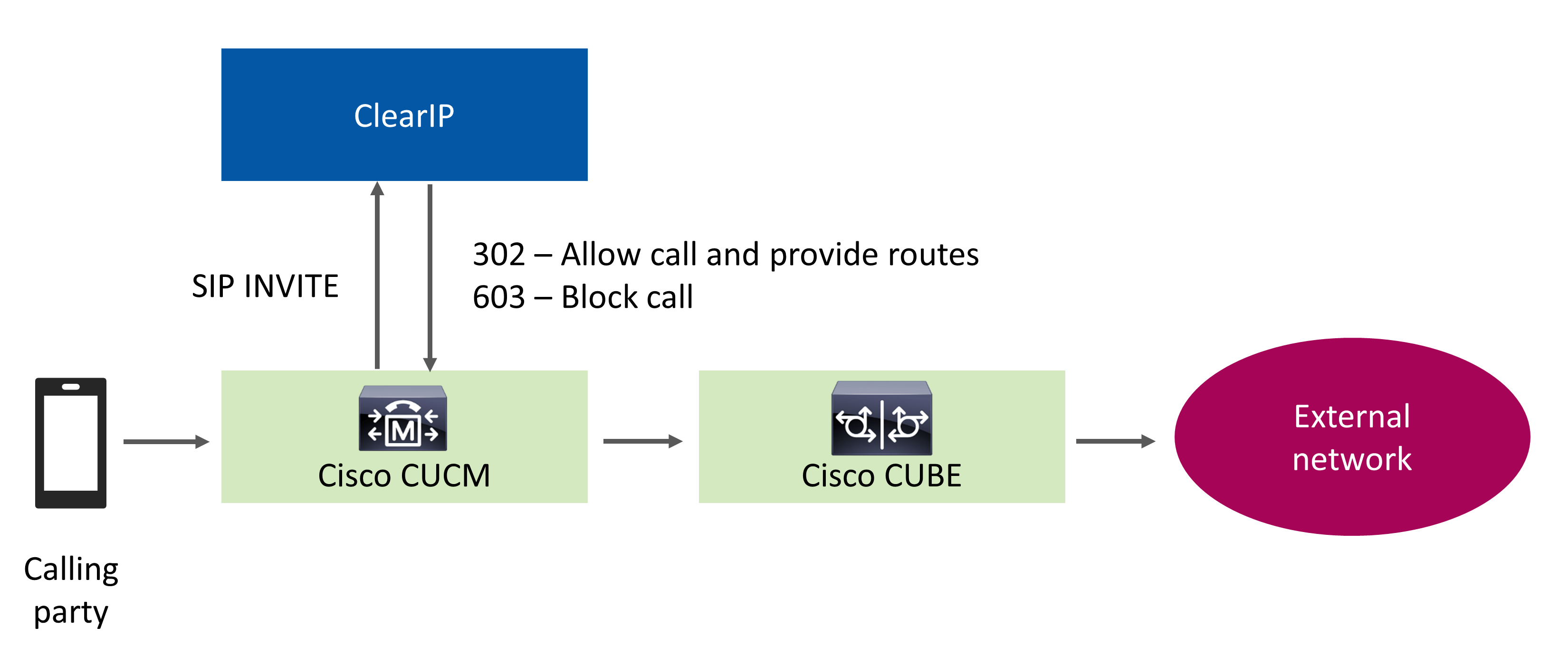
When an outbound call is checked for routing, ClearIP will return to the FreeSWITCH either a:
- SIP 302 with a list of routes in the contact header
- SIP 603 if the call is to be blocked as a result of any other ClearIP service analysis (e.g., fraud prevention, STIR/SHAKEN).
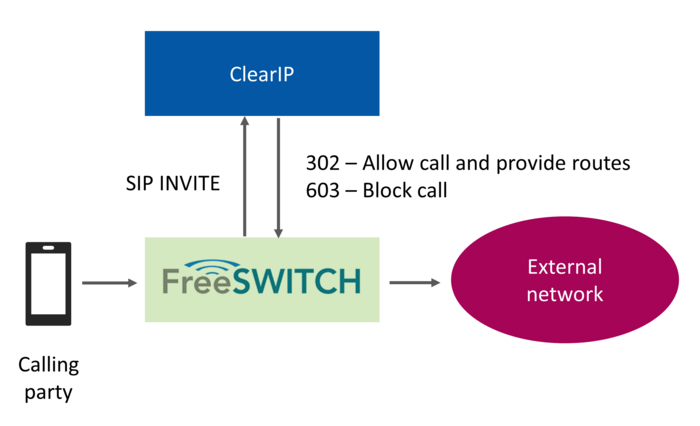
When an outbound call is checked for routing, ClearIP will return to the Kamailio SIP Server either a:
- SIP 302 with a list of routes in the contact header
- SIP 603 if the call is to be blocked as a result of any other ClearIP service analysis (e.g., fraud prevention, STIR/SHAKEN).
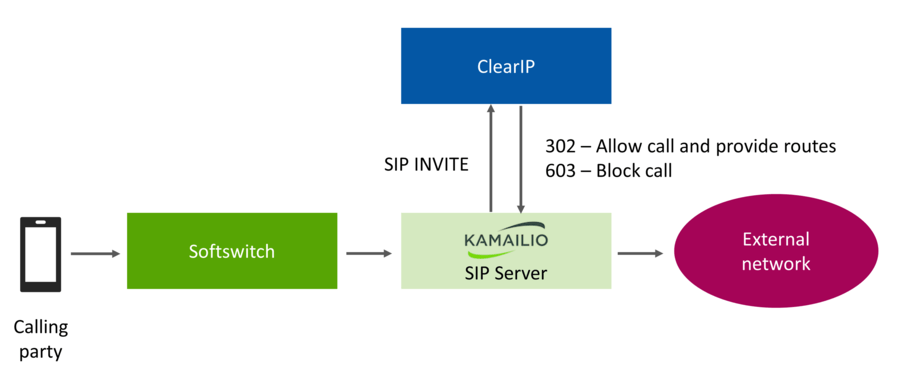
When an outbound call is checked for routing, ClearIP will return to the Metasphere CFS either a:
- SIP 302 with a list of routes in the contact header
- SIP 603 if the call is to be blocked as a result of any other ClearIP service analysis (e.g., fraud prevention, STIR/SHAKEN).
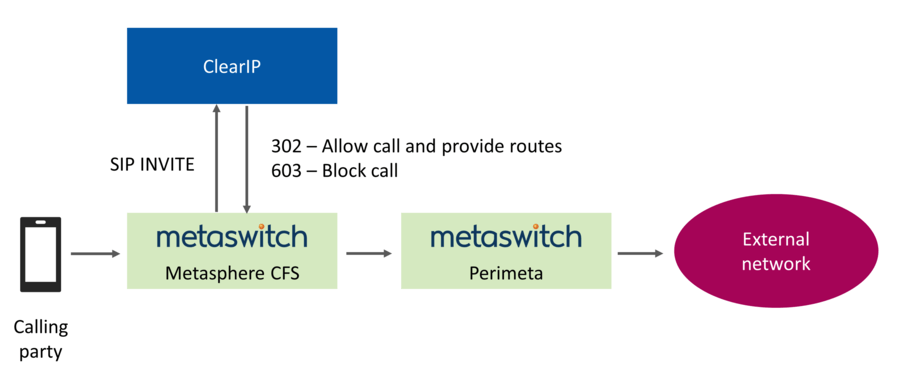
We have provided Metaswitch outbound configuration instructions for ClearIP.
When an outbound call is checked for routing, ClearIP will return to the Metaswitch Perimeta SBC either a:
- SIP 302 with a list of routes in the contact header
- SIP 603 if the call is to be blocked as a result of any other ClearIP service analysis (e.g., fraud prevention, STIR/SHAKEN).
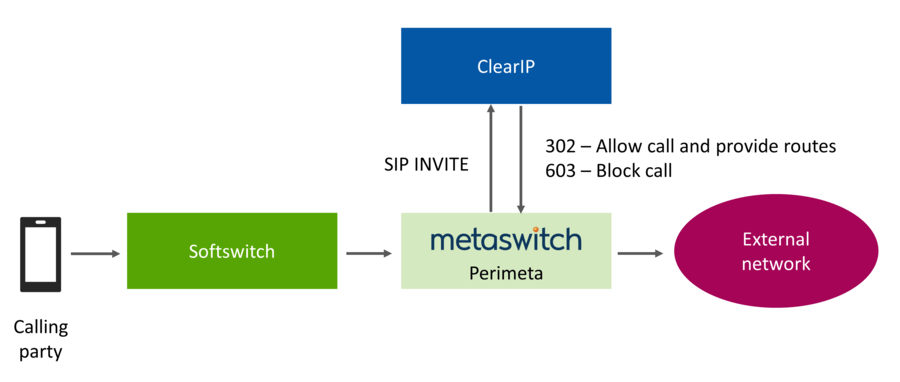
When an outbound call is checked for routing, ClearIP will return to the netsapiens either a:
- SIP 302 with a list of routes in the contact header
- SIP 603 if the call is to be blocked as a result of any other ClearIP service analysis (e.g., fraud prevention, STIR/SHAKEN).
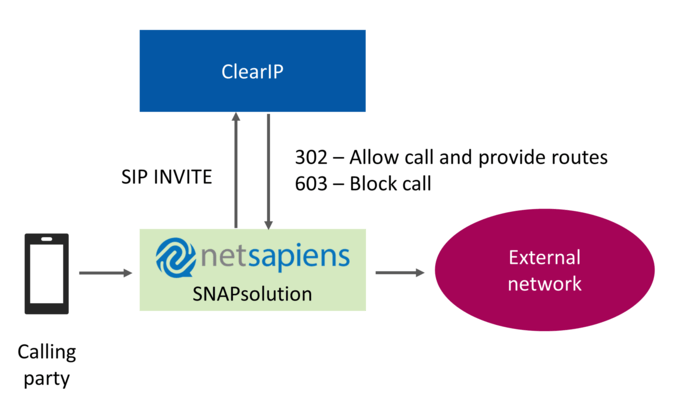
See NetSapiens documentation for more information on configuring their SNAPsolution for integration with ClearIP (login credentials required).
When an outbound call is checked for routing, ClearIP will return to the Oracle Acme Packet SBC either a:
- SIP 302 with a list of routes in the contact header
- SIP 603 if the call is to be blocked as a result of any other ClearIP service analysis (e.g., fraud prevention, STIR/SHAKEN).
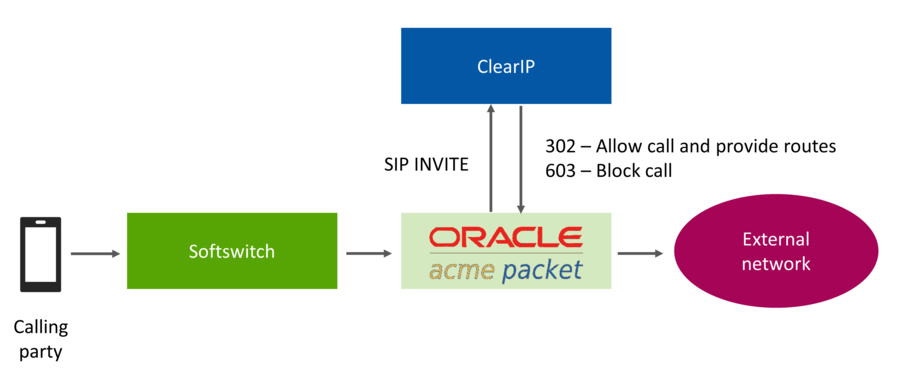
When an outbound call is checked for routing, ClearIP will return to the PortaSwitch either a:
- SIP 302 with a list of routes in the contact header
- SIP 603 if the call is to be blocked as a result of any other ClearIP service analysis (e.g., fraud prevention, STIR/SHAKEN).
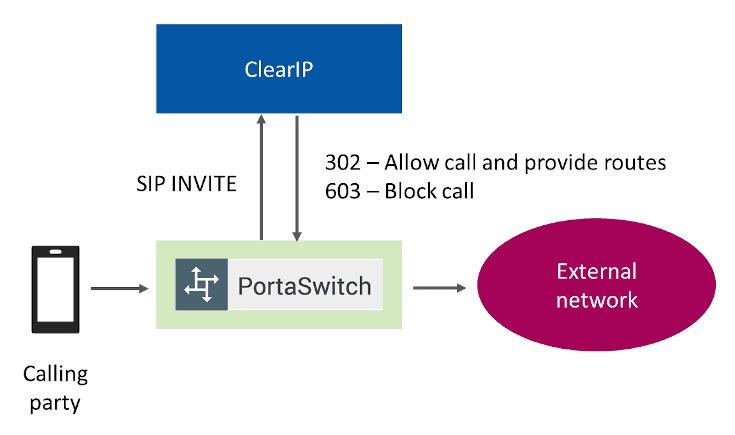
When an outbound call is checked for routing, ClearIP will return to the Ribbon Call Controller either a:
- SIP 302 with a list of routes in the contact header
- SIP 603 if the call is to be blocked as a result of any other ClearIP service analysis (e.g., fraud prevention, STIR/SHAKEN).
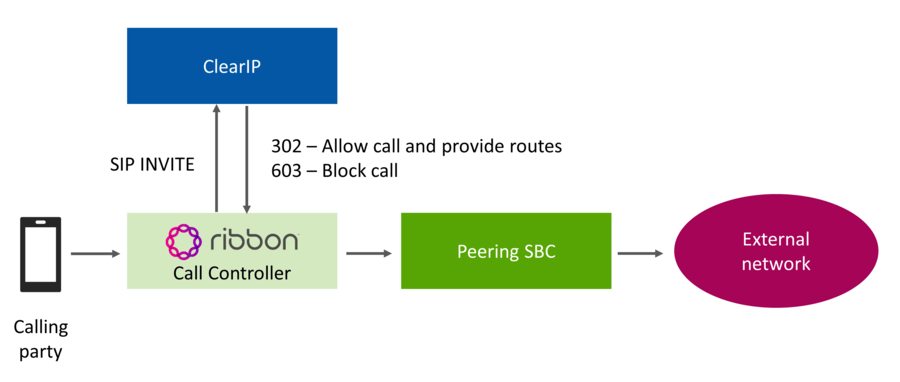
When an outbound call is checked for routing, ClearIP will return to the Ribbon SBC either a:
- SIP 302 with a list of routes in the contact header
- SIP 603 if the call is to be blocked as a result of any other ClearIP service analysis (e.g., fraud prevention, STIR/SHAKEN).
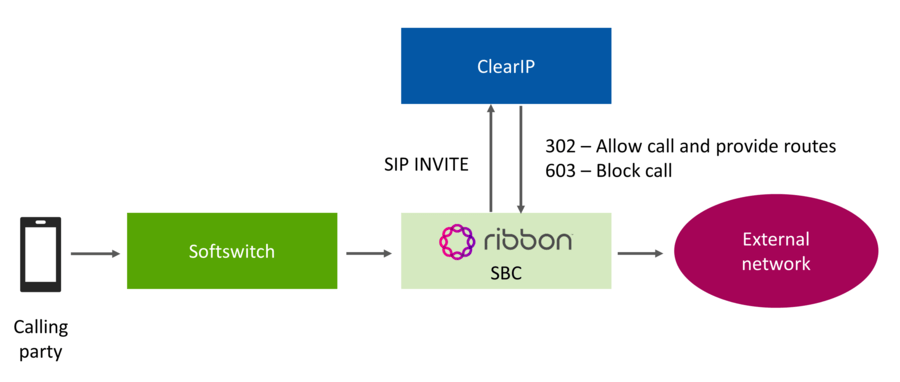
When an outbound call is checked for routing, ClearIP will return to the Sansay VSXi SBC either a:
- SIP 302 with a list of routes in the contact header
- SIP 603 if the call is to be blocked as a result of any other ClearIP service analysis (e.g., fraud prevention, STIR/SHAKEN).
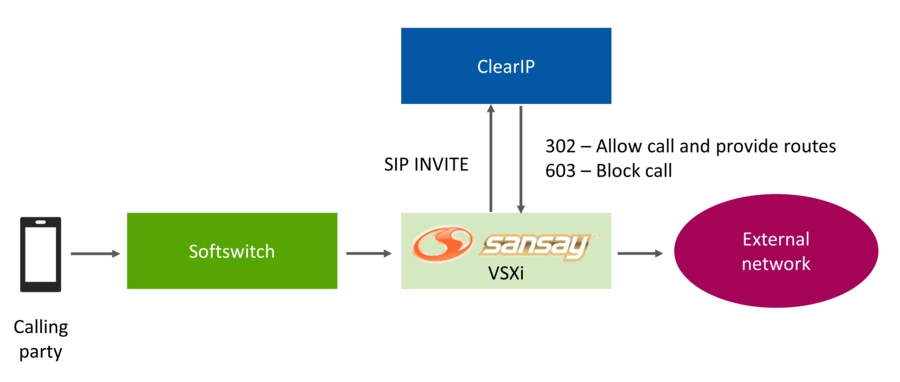
When an outbound call is checked for routing, ClearIP will return to the TelcoBridges FreeSBC/ProSBC either a:
- SIP 302 with a list of routes in the contact header
- SIP 603 if the call is to be blocked as a result of any other ClearIP service analysis (e.g., fraud prevention, STIR/SHAKEN).
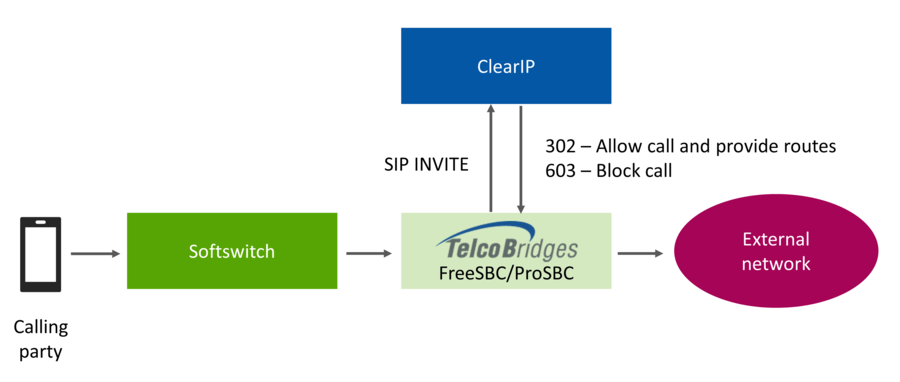
See TelcoBridges documentation for more information on configuring their SBC for integration with ClearIP:
- ProSBC Configuration for STIR/SHAKEN with TransNexus ClearIP service
- ProSBC Configuration for Robocall Mitigation with TransNexus ClearIP service
ClearIP SIP trunk
Configure the SIP device with a SIP trunk directed to sip.clearip.com. SIP messages must be sent using either TCP to sip.clearip.com:5060 or using TLS to sip.clearip.com:5061.
The IP address for ClearIP changes for load balancing and maintenance. That’s why you should configure the trunk using its host name, not static IP address, to avoid any service disruptions when the IP address changes.
Initially, ClearIP will respond with a SIP 403 until your account has been provisioned.
Note: sip.clearip.com does not respond to UDP messages.
Try ClearIP today
Contact us today to learn more.
